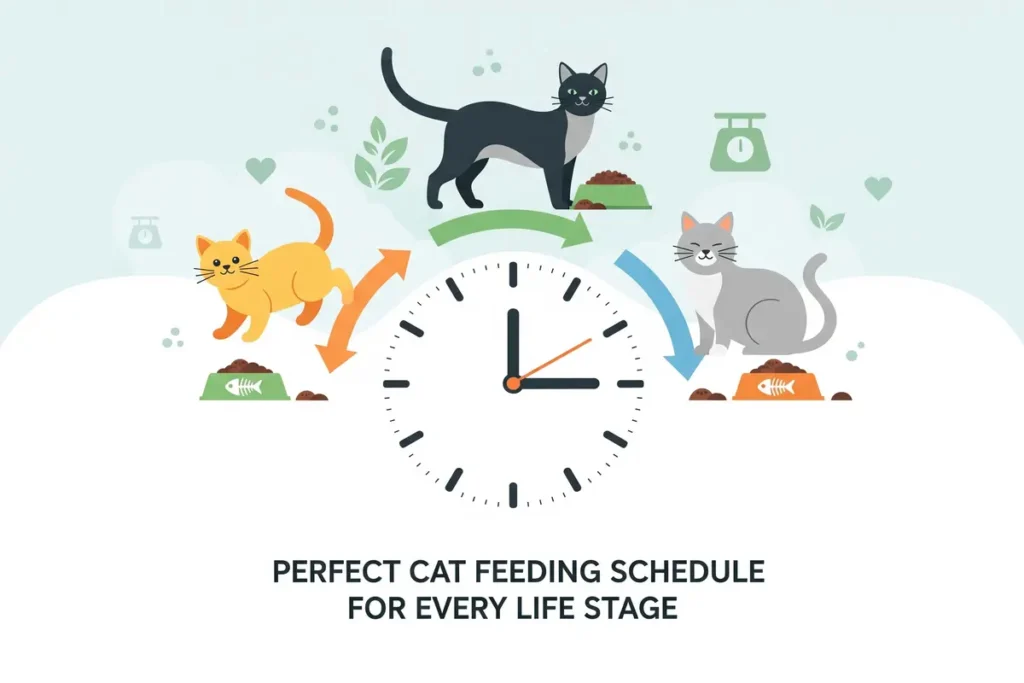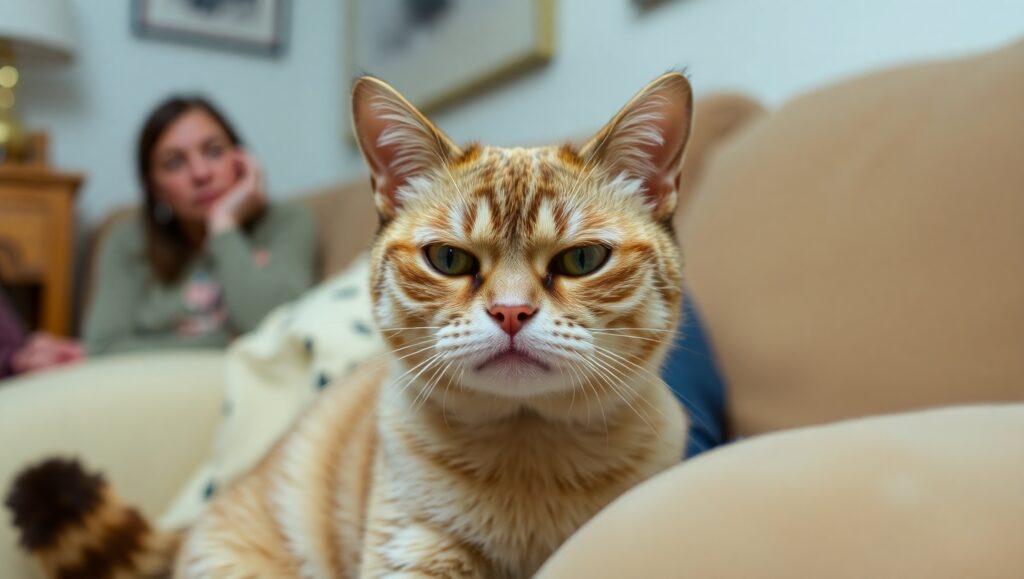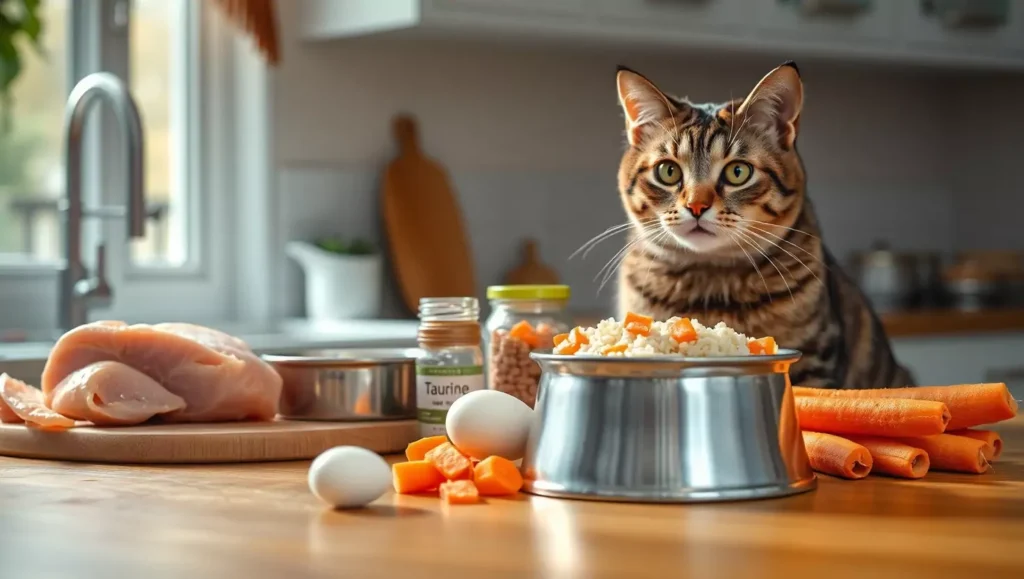If you’re a proud cat parent and a devoted plant lover, you’ve likely asked yourself this question: “Can my cat eat that leaf safely?”. Many of the most common houseplants can be toxic to cats, making cat safe plants essential for creating a home or garden that feels like home without putting your adorable baby at risk.
But the good thing is that there are lots of beautiful, low-maintenance, and safe plants that you can enjoy along with your furry companion. In this guide, we have compiled a selection of expert-approved cat-safe plants from multiple trusted sources, along with safety tips, emergency advice, and additional information.
Why Choosing Cat-Safe Plants Matters
As a plant lover and cat parent, you know the challenge of providing a lush, green home, one that is appealing and safe for your kitty. We can like lush houseplants with colorful foliage, air purifying qualities, and appealing greenery, and many are popular plants when decorating our homes, but many houseplants can harm or kill our feline friends. So, finding safe plants isn’t a design decision; it’s a safety decision.
Making a space for your cats that is safe for them is one of the most important aspects of responsible pet ownership. If you’re new to having a feline friend at home, don’t miss out on some of these essential cat care tips for beginners that can help you have a happy and healthy home.
Common Risks of Toxic Houseplants for Cats
Cats are curious creatures – they can’t help but sniff, paw, and even nibble the things they find interesting. And while that’s a perfectly normal behavior, it can have consequences when it comes to houseplants.
Many popular indoor plants that we as humans often see as harmless or decorative, such as lilies, pothos (devil’s ivy), philodendrons, aloe vera, and peace lilies, contain toxins that are dangerous to cats. A small bite or lick of one of these plants can create a reaction from your cat, particularly if it’s sensitive.
These are some common signs of toxicity in cats when they ingest plants:
- Vomiting or diarrhea: One of the first indications that your cat has eaten something they shouldn’t.
- Difficulty breathing: The swelling could indicate ingestion of a plant that has affected the mouth or throat.
- Excessive drooling or pawing at the mouth because of irritation or burning.
- Lethargy or seizures: In severe cases, certain plants can cause an adverse reaction in the nervous system, and or kidneys, or liver. Tremors, seizures, or collapsing can occur in extremely serious cases, and the animal might not be able to recover.
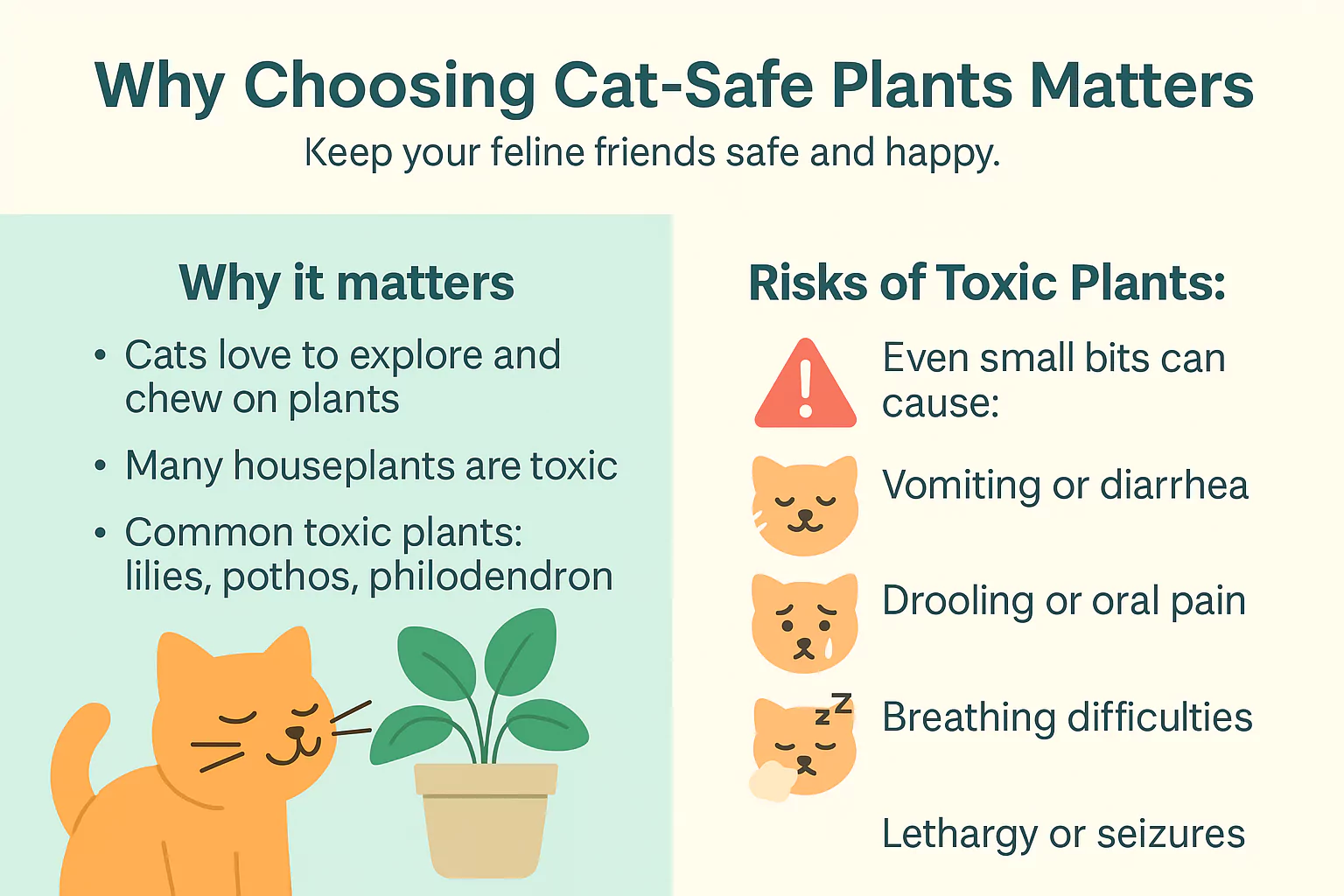
Even more alarmingly, some plants (like Easter lilies) can be lethal to cats. When you expose a cat to Easter lilies, it could lead to death if not treated quickly. It’s also vital to keep in mind that not all symptoms appear immediately; it can take several hours sometimes for symptoms to appear.
Pro tip: Always check to see if a plant is cat-friendly before introducing it into the home. If you are unsure, check places like the ASPCA’s toxic plant list or contact your veterinarian.
How to Spot Symptoms of Plant Poisoning in Cats
Since cats can’t communicate verbally and tell you how they’re feeling, you need to be more aware of their behavior and the physical changes that can happen in their body as well, especially if you have recently introduced new plants into your home.
Even if your cat only seems mildly affected, don’t let it go! It may only take a few hours for something minor to become serious, or even life-threatening. One day, your cat is fine, the next it is sick because of something they chewed and ingested the day before.
Here are some common symptoms to watch for:
- Sudden drooling: A classic sign of an irritated mouth, or a reaction to something bad/tasting.
- Vomiting or diarrhea: Usually, the body’s first attempt to rid itself of something that it’s perceiving as poisonous.
- Loss of appetite: If your usual cat is suddenly turning her nose up at dinner, that is something to pay attention to.
- Unusual hiding or lethargy: Cats are known to retreat somewhere quiet when they are not feeling well.
- Tremors, disorientation, or wobbly walking: These are more advanced symptoms and suggest there is involvement with the nervous system.
Tips to Prevent Your Cat from Nibbling on Plants
Even when you’re sure that all your plants are safe for cats, it’s still a good idea to discourage chewing. Why? Some cats over chew, and while most plants are safe and secure, they can still get some mild upset to their stomachs with non-toxic plants, and your lovely plant babies will end up destroyed.
Some cats will chew on plants out of boredom or as a form of stimulation, just as they may scratch furniture. Providing stimulating toys and other options for scratching may help. For more information, learn more about how to stop cats from scratching furniture.
So here are some cat-parent approved tips to prevent unwanted plant munching.
Keep Plants Out of Reach
Place your greenery on high shelves, hanging planters, or wall displays. While cats are great climbers, removing the ease of access will help.
Use Natural Deterrents
Cats dislike citrus smells, vinegar, or certain herbs. A little diluted lemon juice or bitter spray (from the store) on the base of your plants may keep them away. Test in advance, as some delicate leaves may not react well to sprays.
Provide a Safe Chewing Option
Give your cat something of its own to chew, whether that is catnip, cat grass, or valerian root. These chews are safe and even good for them to consume in moderation. It gives them the satisfaction of chewing without the danger.
Keep Them Mentally Stimulated
Sometimes, your cat will chew if they are bored and in search of stimulation. Provide plenty of toys, scratching posts, window perches, or treat puzzles to keep them mentally and physically stimulated.

Most Popular Indoor Cat-Safe Plants
If you’re a plant parent, a cat parent, or both, getting the right plants is a crucial step to keep your home looking chic while ensuring your pet is safe. These indoor plants are gorgeous, low-maintenance, and 100% non-toxic to cats. Each of these plants will fit perfectly in your cat-friendly home.
Let me take you through the popular indoor plants that are cat-safe and are completely worthy of your curious cat.
Spider Plant (Chlorophytum comosum)
The spider plant is a well-known houseplant, loved for its long, arching leaves and baby offshoots called “spiderettes.” These dangling and trailing offshoots are “picture perfect” for cats, so it’s understandable when they are sent to be the most tempting feature. Luckily for you, this plant is entirely safe for cats, so you won’t feel too much anxiety if your cat decides to nibble or play.
Spider plants are extremely low, making them a great choice for beginners.They do best in bright, indirect light but can also do well in low-light conditions. They are also effective air purifiers, removing toxins from your indoor air. They are very easy to propagate so that you can grow more or even share them with friends.
Why it’s awesome for cat people:
- Completely safe and non-toxic for cats
- Amazing air purifier
- Does great in bright, indirect light
- Fairly low-maintenance, fast-growing
Spider plants also thrive in hanging baskets, which will add some dimension to your space and keep the plant away from little paws, if you need to. These plants are practical for pet owners.
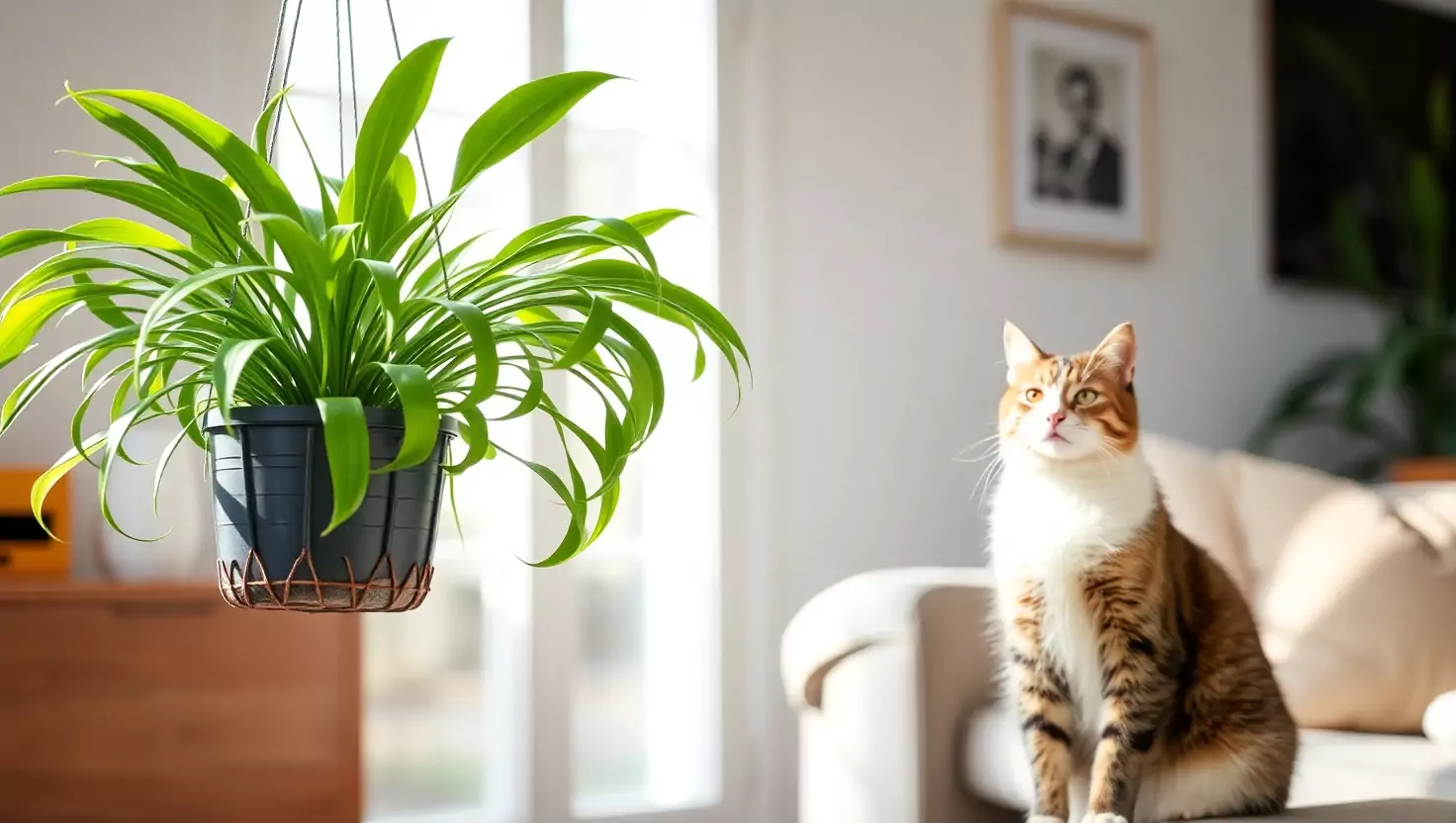
Chinese Money Plant (Pilea peperomioides)
The Chinese money plant, known for its adorable pancake-like leaves, has been one of the most fashionable indoor plants in recent years. Its round, coin-shaped leaves grow on long, thin stems, giving the plant a unique and playful look. The Chinese money plant will liven up any shelf or desk, and it’s 100% safe for cats, so you can style it anywhere your cat may stray.
This plant is easy to care for and loves bright, indirect light. It also quickly produces baby shoots at its base that can be gently and easily separated from the mother plant and grown into new plants. Your cat may find the unusual leaf shape cute, and you can relax knowing that it is a non-toxic plant, so small amounts are not an issue if your cat nibbles on it.
Reasons to love it:
- Cat-safe for nibbling
- Super easy to propagate (hello baby plants!)
- Loves bright, indirect light
- Perfect for windowsills and tables
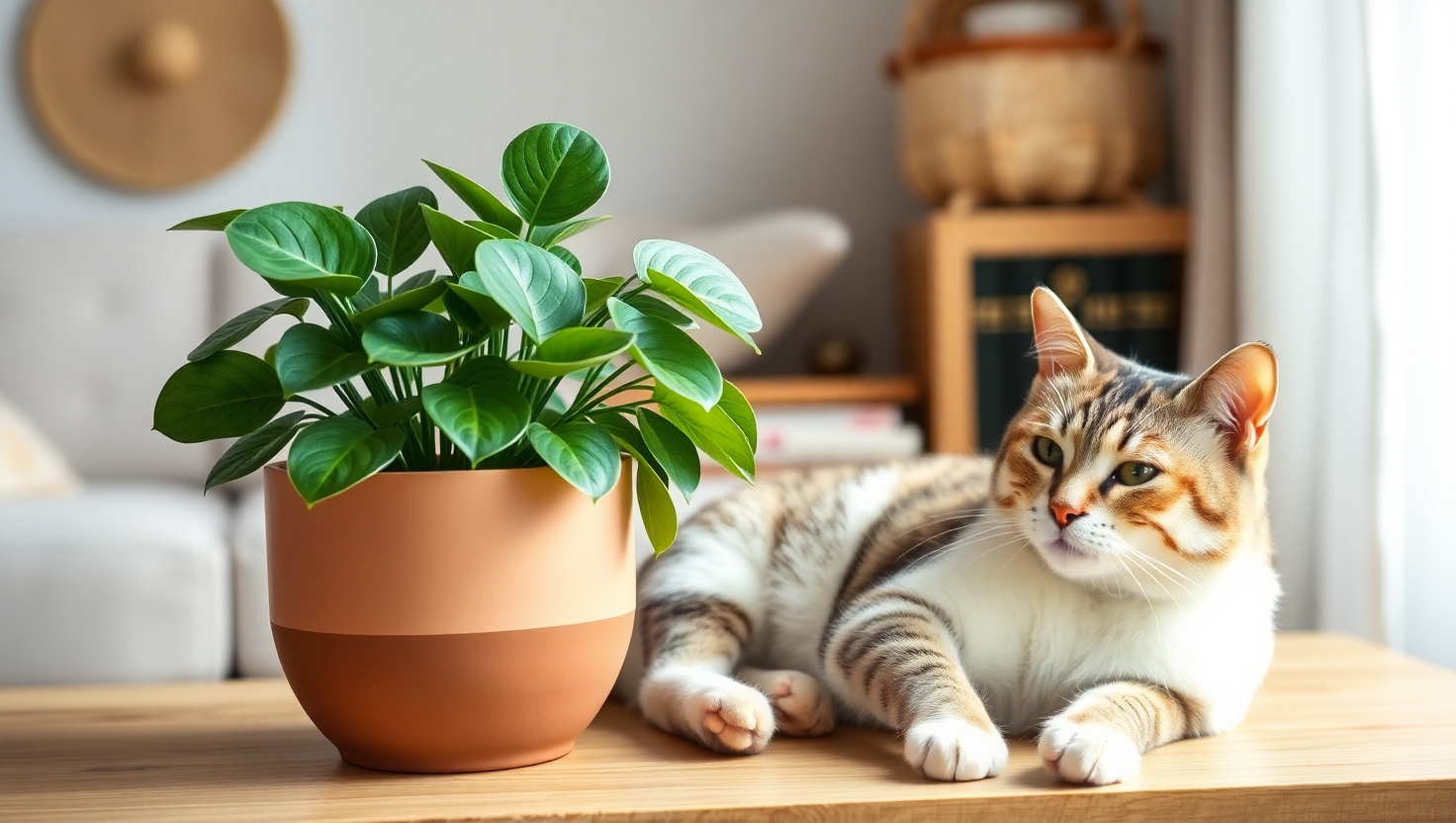
Money Tree (Pachira aquatica)
The money tree is a beautiful tropical plant that you can use as a gift to represent good luck, prosperity, and positive energy. With its unique braided trunk and large, shiny leaves, a money tree makes a decorative statement in any room and is completely cat safe! If your cat rubs on it or swats at its leaves, you are in no danger.
This plant likes bright, indirect light and some humidity, so it works really well in sunny kitchens or living rooms. Money trees can grow quite tall indoors if given the right conditions, and they are very low-maintenance, as they will do well with periodic watering. It is a lovely and meaningful plant that looks beautiful and is also safe for your pet.
Why it’s the best choice:
- Non-toxic and safe for cats
- Symbol of wealth and positivity
- Grows well in bright, indirect light
- Can tolerate less water regularly or only if required.
- Its height and palm leaves make it the perfect plant for the corner or areas in the living room, where the cat wants to lounge.
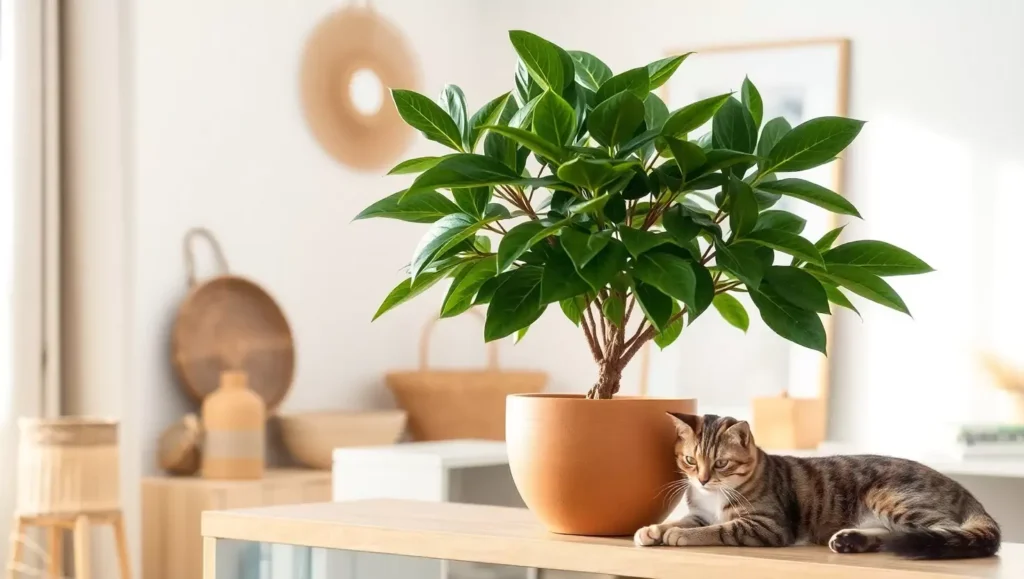
Calathea (Orbifolia & Sanderiana)
Calatheas, sometimes called ” prayer plants”, are among the most stunning houseplants available. For example, Calathea Orbifolia has wide, silver and green striped leaves, while Calathea Sanderiana has darker leaves and light pink or white pinstripes. The bold foliage is appealing to plant enthusiasts who want something dramatic that is safe for their pets.
They’re non-toxic to cats, and while they do take some extra attention, they are worth it. Calatheas thrive on humidity, consistent moisture, and avoid direct sun. With a few sprays of water and some care, they will provide visual life and texture in your space, and if the cat decides to chew on them, it’s perfectly safe.
Reasons why Calatheas are great in homes with pets:
- Non-toxic to cats
- Come in a variety of beautiful types (example: Orbifolia with silver stripes, Sanderiana with pink edges)
- Can thrive in medium to bright, indirect light
- Loves humidity – so they are great in bathrooms/kitchens.
- They may be somewhat more sensitive to overwatering, but they flourish beautifully in homes with pets with proper care.
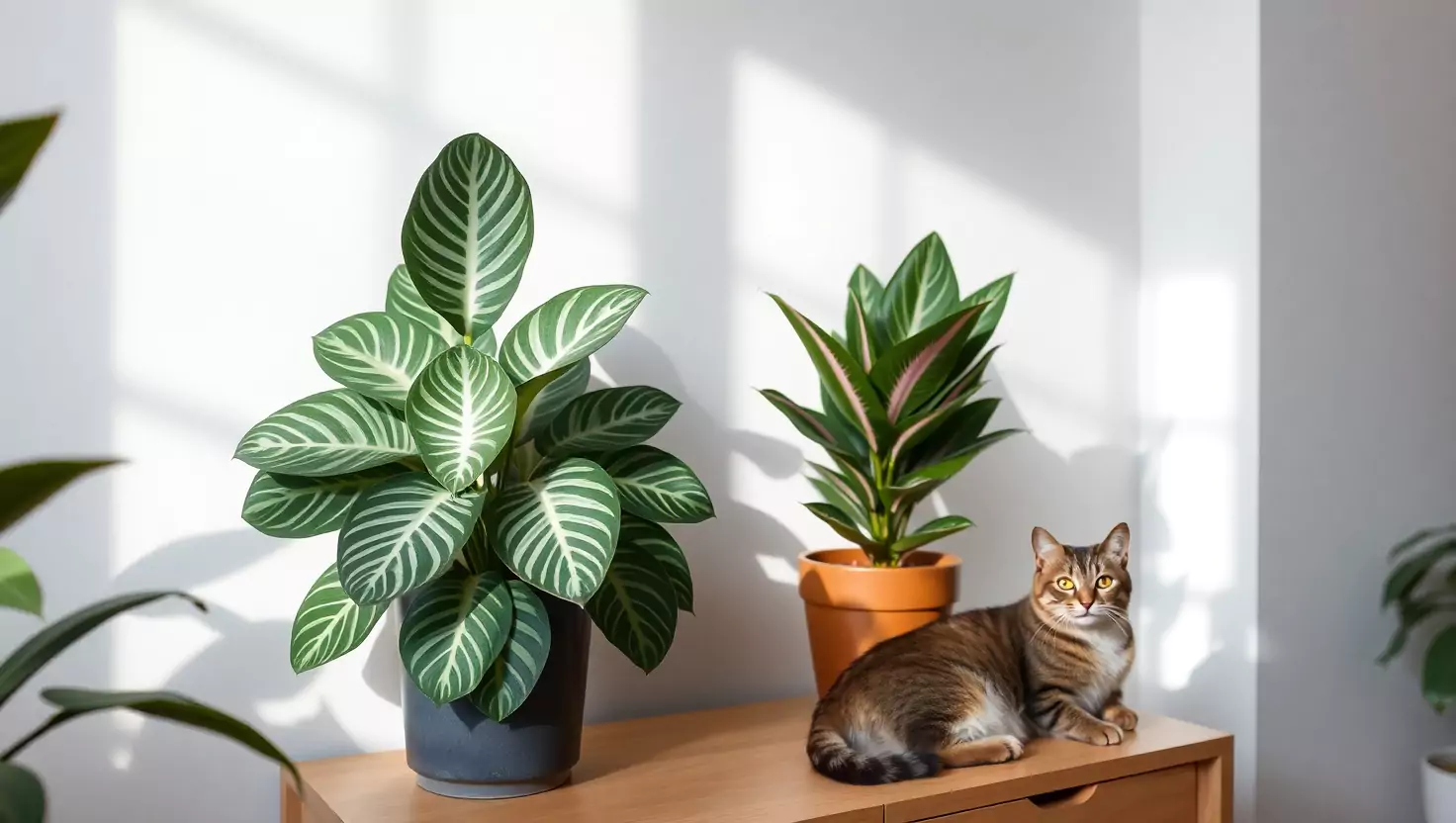
Boston Fern (Nephrolepis exaltata)
If you are trying to develop an indoor tropical/jungle environment, consider getting a Boston fern. It will spread out, making nice feathery fronds that will billow out and provide fullness and texture of soft green in your space. And yes- it’s also cat-safe. Although they may be curious and nibble on it, you do not have to worry as it is not harmful.
Boston ferns thrive under bright, indirect light and high humidity, making them great choices for bathrooms, countertops, or kitchen countertops. Boston ferns are also natural air purifiers, so this is just another great bonus for any home. You can keep your Boston ferns happy by keeping the soil moist and misting them every once in a while. It is a classic to have in a home, a classic option that adds charm and assurance.
Why pet parents love it:
- Safe if a cat tastes a bit
- A natural air-purifier
- Great for bathrooms or kitchens with adequate humidity
- Looks beautiful in hanging planters or pedestals
- Keep it damp, or mist occasionally, and your fern and your cat will love you for it.

Kentia Palm (Howea forsteriana)
For some tropical elegance in your space, consider the Kentia palm. This tall, beautiful palm has an arching frond that will make your house feel more like an island getaway, and the best part? It’s 100% non-toxic to cats! It’s a great option for pet parents who want something attractive and non-toxic.
Kentia palms are also incredibly hardy and low-maintenance. They can tolerate different light levels, from bright-filtered light to darker corners of your space, and require little watering. It is a low-maintenance plant that will last long, all while providing height and drama to your space, and not stressing your pets if they decide to take a bite.
Why is it the best choice?
- Non-toxic and cat-friendly
- Accepts low light and dry air indoors
- Brings tropical elegance to living rooms and offices
- Doesn’t care if watering occasionally
- Just don’t put it in a cold draft or with hot air blowing on it; this palm likes stability.
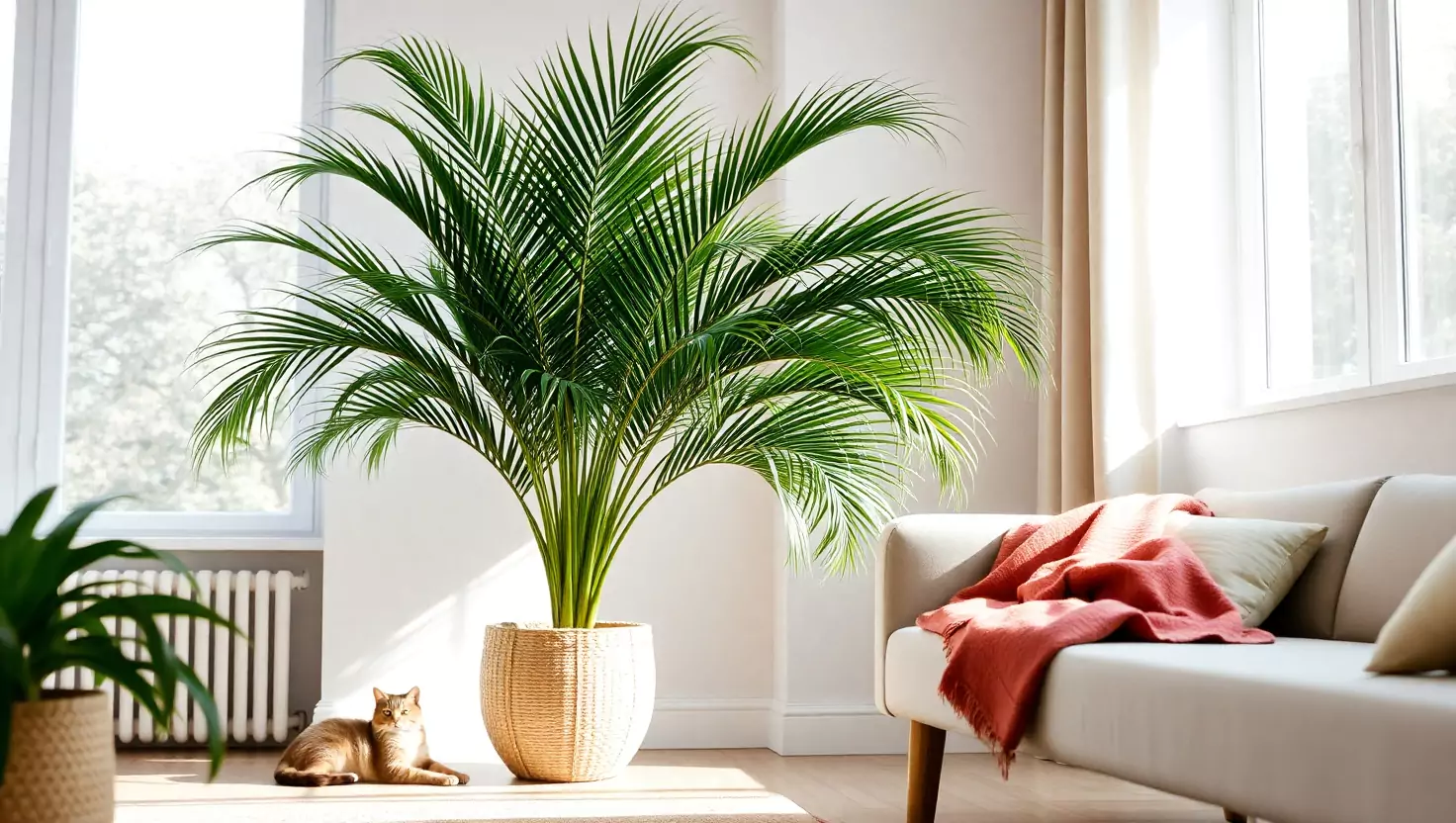
Parlour Palm (Chamaedorea elegans)
If you are looking for an elegant plant that is extremely easy to care for, then the Parlour Palm may be your perfect option. Its feathery fronds and upright growth are classic, yet provide an old-school charm that works well in modern interiors. It is also one of the most cat-friendly plants to grow, which is a bonus for both style and safety.
Parlour palms are tolerant of low light and infrequent watering and make a great choice for those living in apartments or for those who are new to plants, as they are very forgiving. They are slow to grow so that they won’t take up your space, plus they are wonderful air purifiers. Even the most curious feline can sniff and bat at them without concern.
Why it’s the perfect choice for cat owners:
- Totally cat safe
- Does well in low to moderate light
- Requires minimally invasive maintenance
- Gently and noiselessly purifies the air indoors..
- It’s especially popular in apartments or small rooms, where you want to add green, but the maintenance will be a hassle.
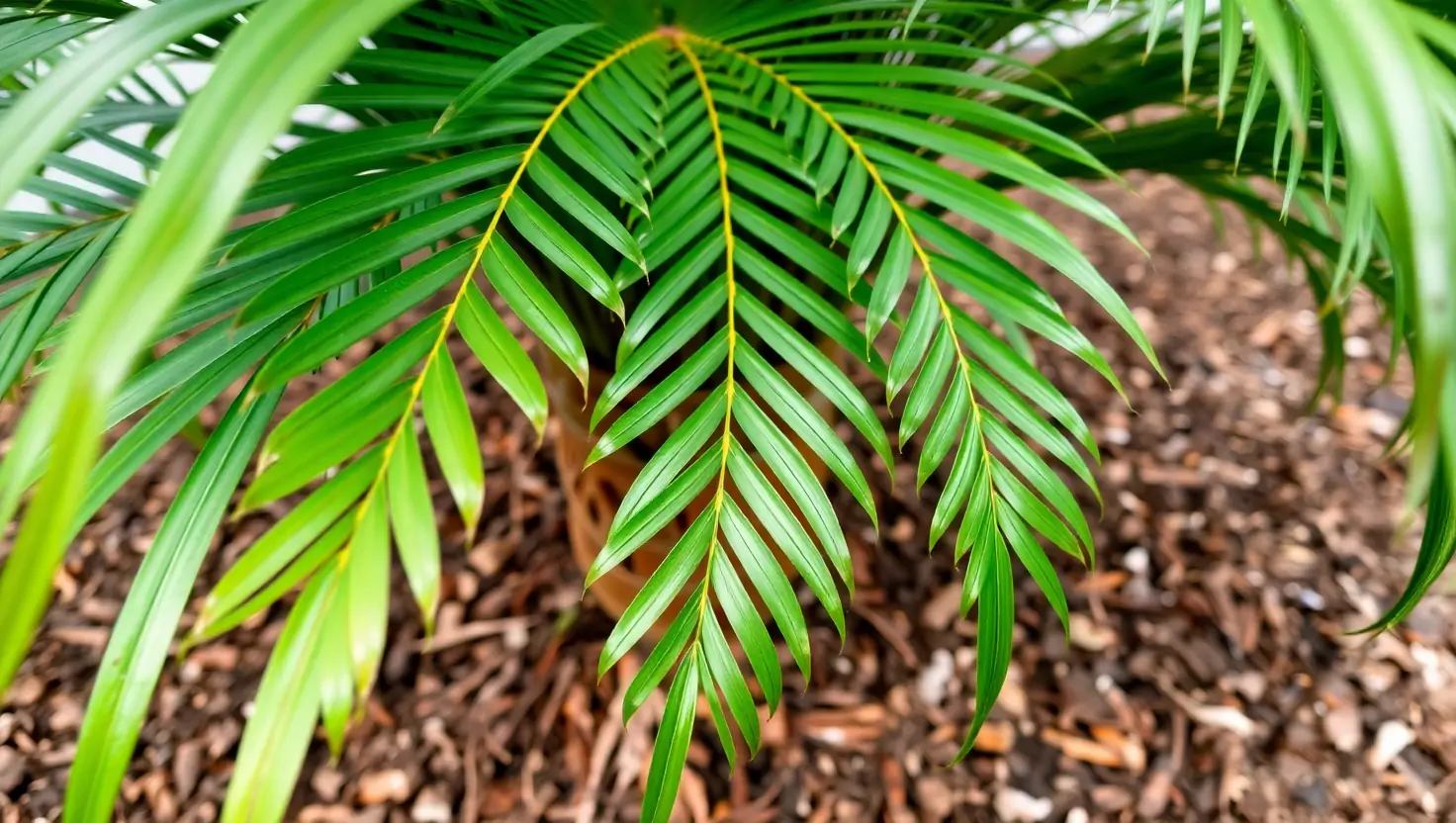
Final Tip:
With these safe plants, it’s always a good habit to observe your cat’s behaviour. While the plants on this list are non-toxic, nibbling on any plant excessively can lead to a mild stomach upset. To be extra safe, provide a source of cat grass or catnip as an alternative to nibbling on your plants.
Safe Outdoor Garden Plants for Cats
Making a garden beautiful while being cat-friendly is much easier than it seems. These outdoor plants have great colours, attract pollinators, and most importantly, they won’t harm your inquisitive cat if they happen to smell or nibble on them. From herbs to flashy blooms, with these plants, your yard will be a legitimate pet-friendly haven.
Catnip (Nepeta cataria)
Catnip is the rock star of any cat-friendly garden. Each loves catnip because of the compound nepetalactone, which stimulates playful and euphoric behaviour in cats. Most of the time, your cat will be rolling, rubbing, or lounging with joy beside this plant. Catnip has other uses as well, though, as it also produces lovely lavender flowers that add even more beautiful appeal to your garden.
This herb is easy to grow, with a preference for full sun and well-drained soil. It can spread quickly, so planting in pots or bordered areas may help manage growth. It also shares the experience of attracting beneficial insects like bees, but it will also help repel some pests. It is fun, functional, and feline-approved!
Key Characteristics:
- Encourages the playful behaviour of cats
- Attracts bees and pollinators
- Pest and virus resistant, and easy to grow in containers or beds
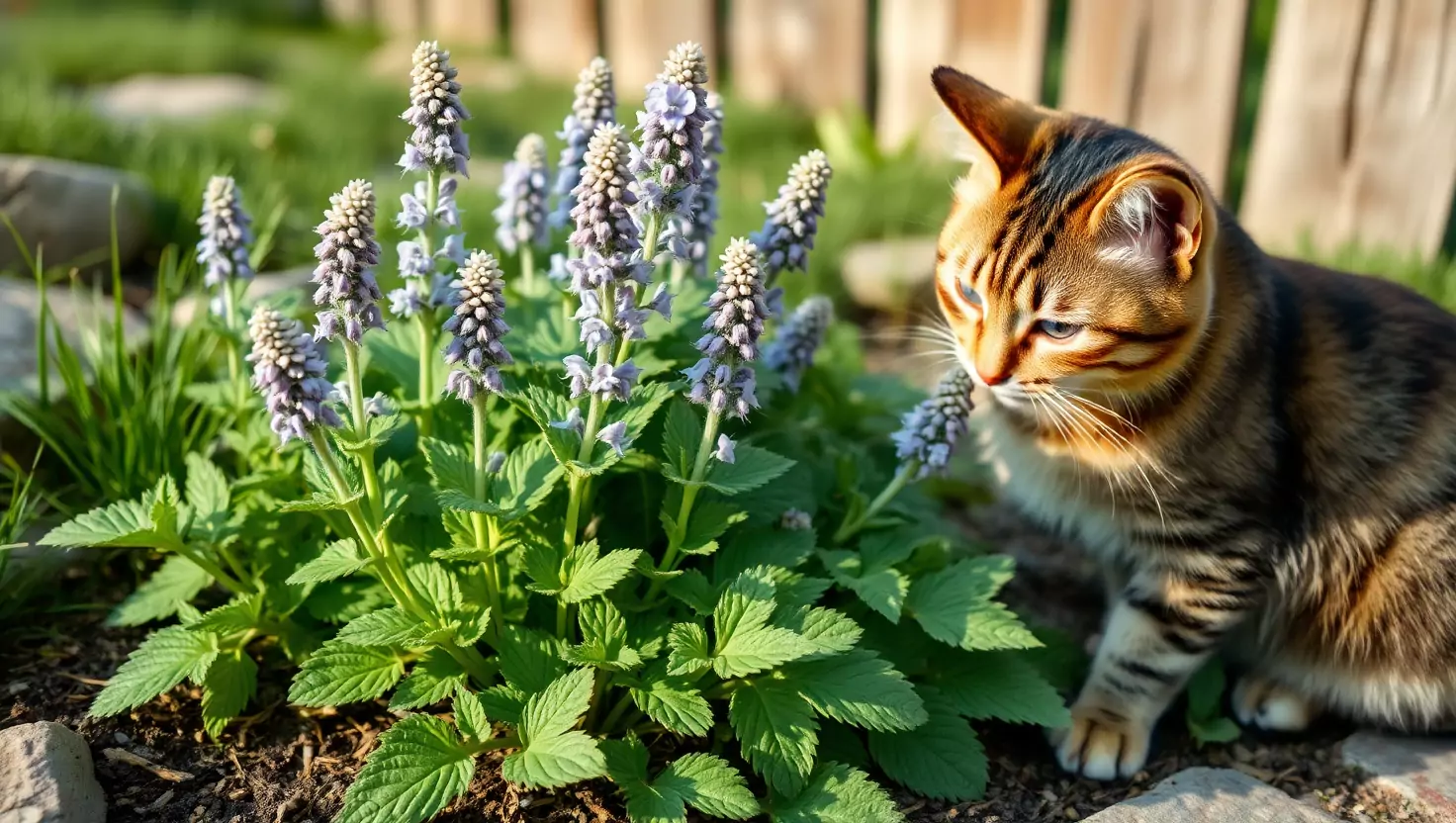
Valerian (Valeriana officinalis)
Valerian has a wonderful mix of functionality as well as beauty. It is known for the calming effects it has on us humans (especially as tea), yet it has the opposite effects on cats, making them playful and energetic, like the effects of catnip. Valerian blooms pink-white flowers in mid to late summer, and releases a sweet scent which appeals to pollinators.
It likes rich, wet soil and sunny to part-shade conditions. This tall perennial grows up to five feet, which makes it a great backdrop in flower beds or borders. Valerian is a good choice for wellness and beauty since it attracts both humans and cats.
Features:
- Natural stimulant for cats
- Stunning pink flowers & sweet-smelling scent
- Attracts butterflies and bees
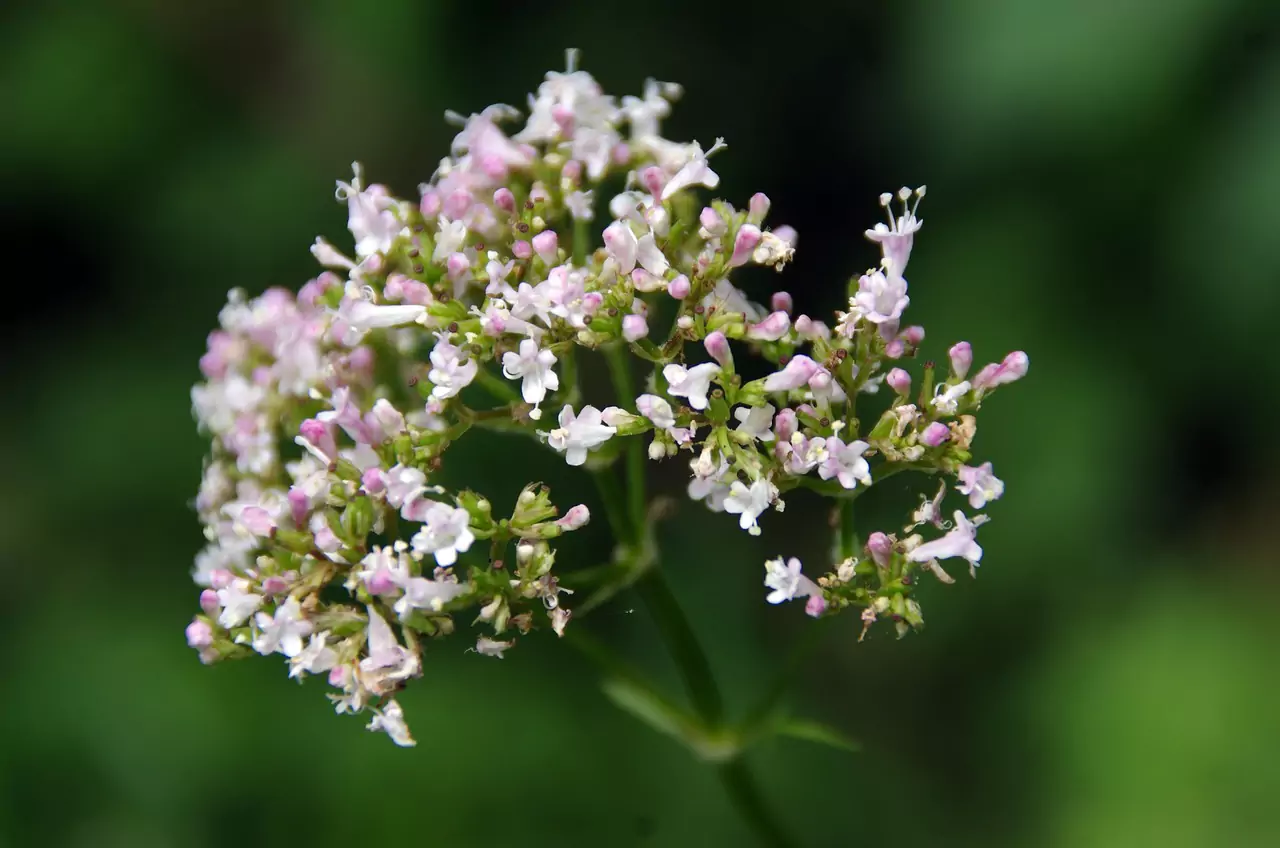
Sunflower (Helianthus)
Sunflowers are vibrant, happy, large flowers that warm up outdoor spaces. Non-toxic to cats, these flowers are safe for smelling or rubbing against. While cats don’t usually eat sunflowers, if they do taste them, there is no cause for concern.
These easy-to-grow annuals prefer full sun and rich soil and are another option for adding height to your garden. With their big leaves, they may even provide a shady spot for your cats to lounge under. In fall, the seeds attract birds, making your garden a wildlife haven.
Top features:
- Tall, striking flowers
- Safe shade for cats
- For the birds and pollinators to observe
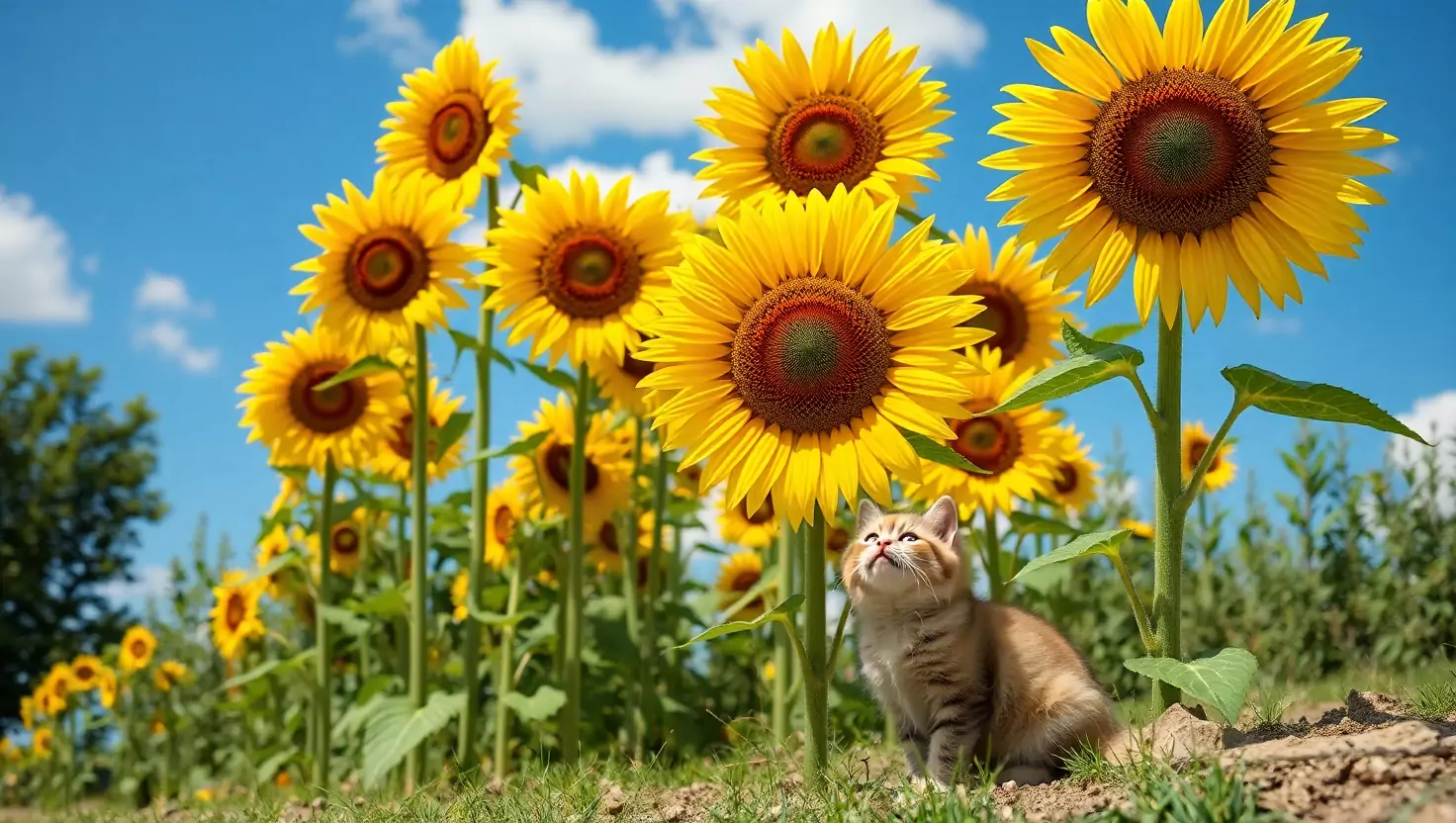
Asters (Aster amellus)
Asters’ colorful daisy-like perennial flowers peak from late summer to fall, right when many flowers are blooming. Their brilliant and attractively colored purple, pink, or blue petals will brighten your garden and attract butterflies and bees. And they are non-toxic to cats, so you can let your cat explore the flowers without worry.
They’re simple to maintain, needing full sun to partial shade with well-drained soil. Asters look great in borders or along garden pathways, allowing cats to lie nearby or walk between the blooms. They provide great pops of color right when your garden could use it.
Top Features:
- Late bloomers
- Great colors for fall gardens
- Pollinator magnets are great for cats.

Zinnias (Zinnia violacea)
Zinnias are the cheerful, colorful performers of the summer garden. Available in every bright color imaginable, these annuals bloom from summer until frost, and their happy blooms make great cut flowers to bring indoors. Don’t get worried if your cat decides to swat at the petals.
Zinnias are relatively easy to care for and thrive in sunny locations with well-drained soil. They can be grown in beds or containers, and they attract butterflies, but they are not attractive to chewers. Zinnias are also tough flowers that are resistant to pests, making them a wonderful option for new and experienced gardeners alike.
Top Features:
- Vibrant, long-lasting blooms
- Friendly to pollinators and for cut flowers
- Non-toxic and hardy
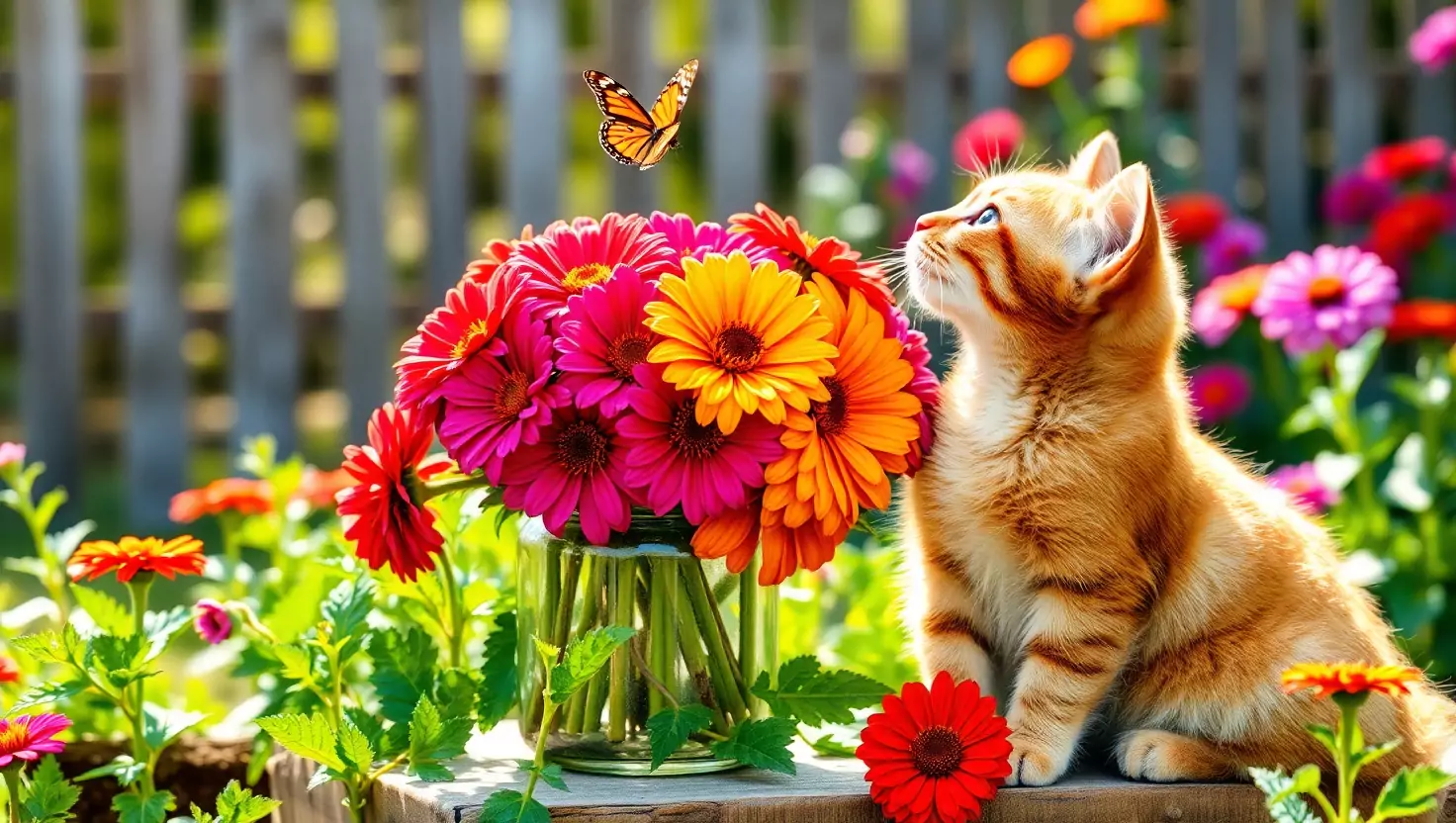
Snapdragon (Antirrhinum)
Snapdragons are whimsical plants with fun blooms (that look like dragons) that kids and adults love — and luckily, they are safe around cats, too. Offering almost every color of the rainbow, snapdragons are an eye-catching way to increase color in your flower beds and containers.
Snapdragons thrive in cooler weather while appreciating full sun or partial shade. Their tall stalks and vertical blooms create an interesting layering in your garden design. These fun flowers are perfectly safe, animal-friendly, and bloom heavily in the spring and fall, creating a garden design that you will be able to enjoy year-round.
Best Features:
- Funny blooms everywhere with so many color options
- Safe for pets and kids alike
- A favorite cool-season garden plant
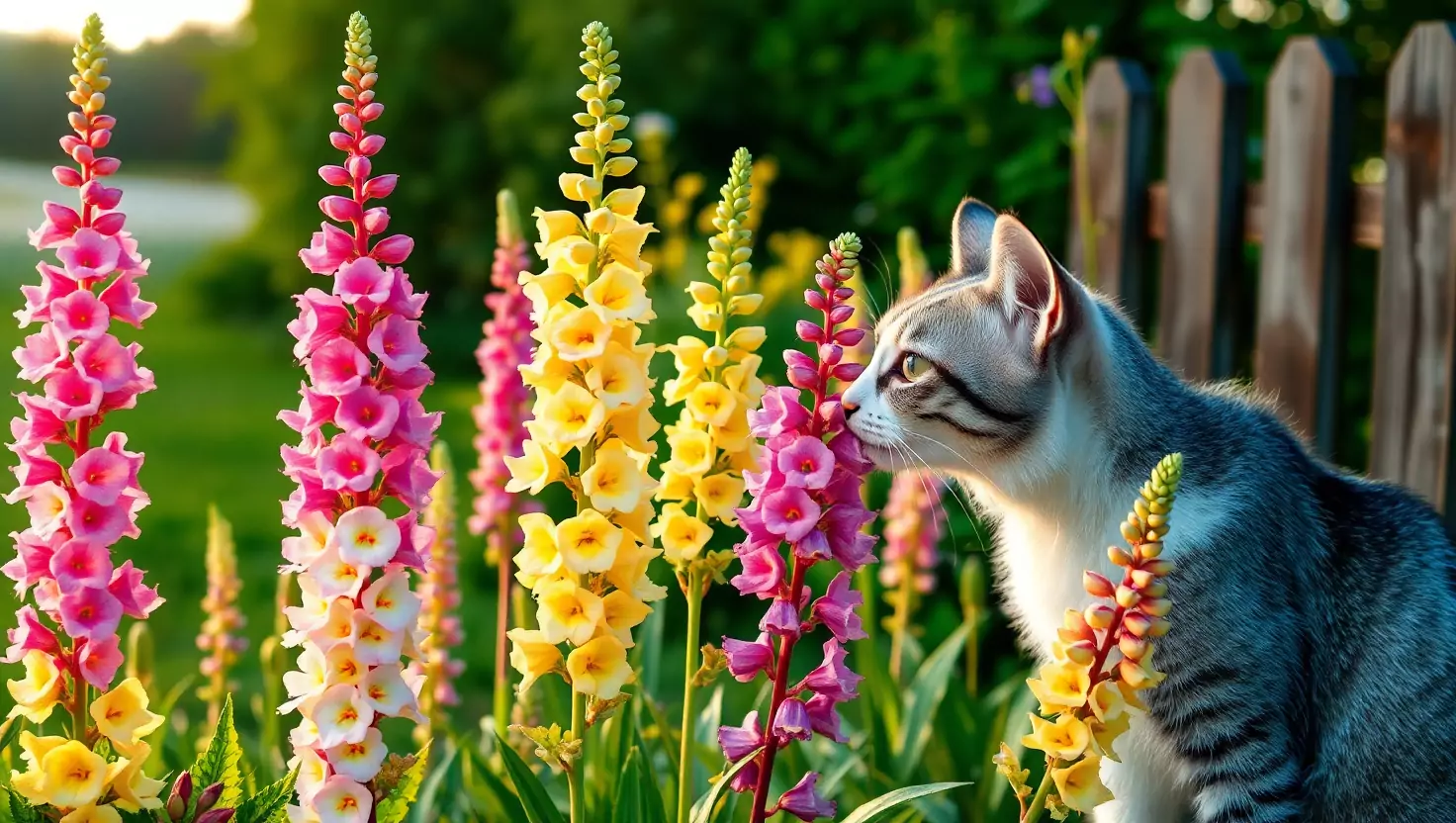
Cosmos (Cosmos bipinnatus)
Cosmos are beautiful but wonderfully fragile flowers with daisy-like flowers in white, pink, and purple. They are tall and thin with feathery foliage that sways in the wind. Gardeners favor Cosmos for their soft, romantic nature in the garden. They are also best for all of us and are safe for cats.
These stress-free annuals can handle poor soil and enjoy full sun, making them ideal for laid-back, cottage gardens. Butterflies and bees love the nectar-rich flowers, and their height provides hiding spots for an exploring kitty.
Best Features:
- Feathery, beautiful flower petals
- Cat-friendly and provides pollinator food
- Great for gardeners with poor soil, and it’s even easier to grow.
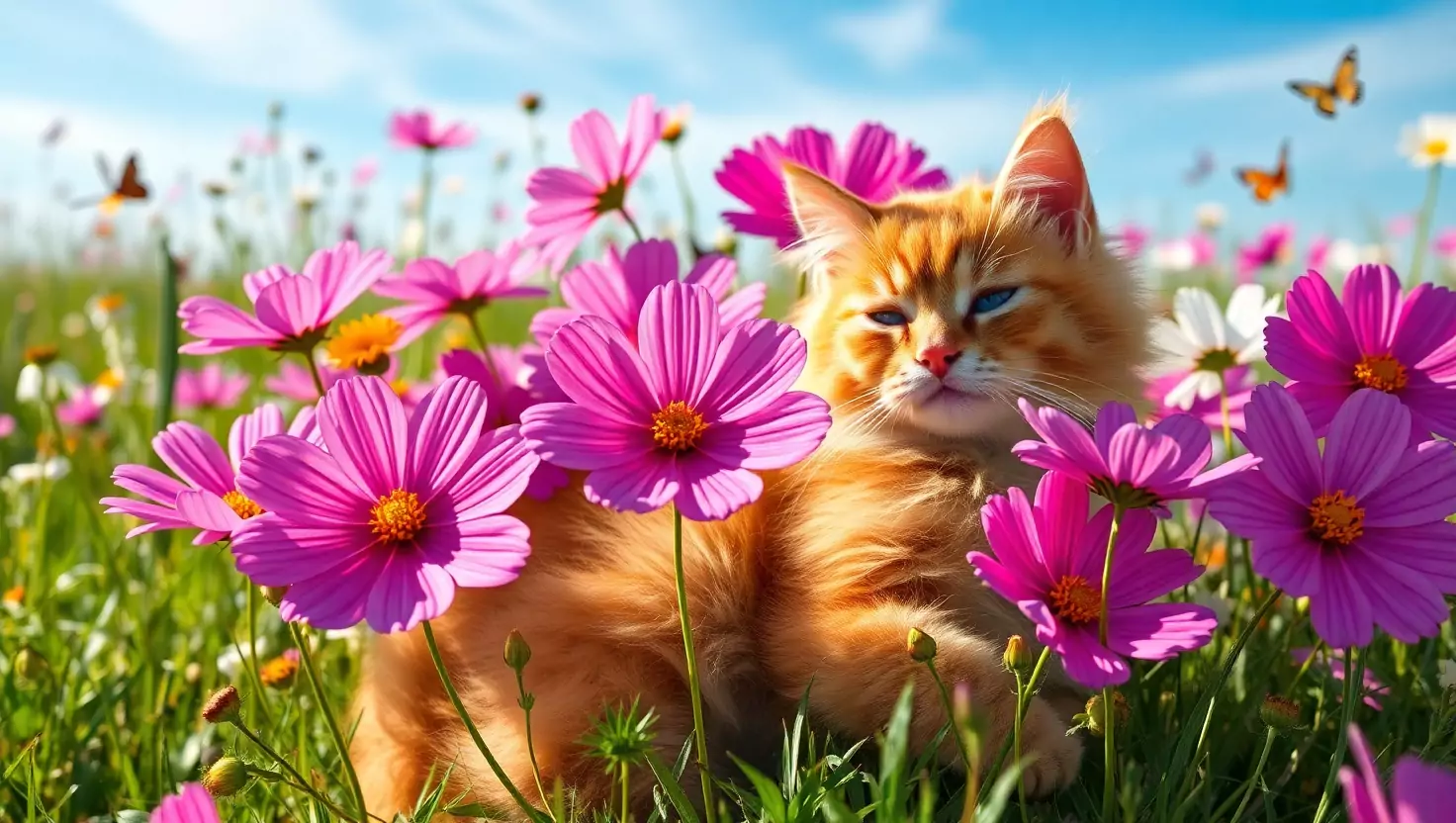
Safe Edibles & Herbs for Cat-Friendly Homes
If you want to grow some plants that are useful in your kitchen and safe for your cats, many common herbs and edibles are non-toxic for your feline. They are perfect for a sunny windowsill, sunny kitchen counter, or even if you have a balcony garden. And, they can add flavor to your meals as well as brighten your cat-friendly space.
Rosemary (Salvia rosmarinus)
Rosemary is a resilient evergreen herb that has a lot of character from its rugged, needle-like leaves to its strong aroma. It is a staple in the kitchen used to season everything from potatoes to roasts, plus it is non-toxic to cats. Some pet owners even report that it can aid with digestion or naturally repel fleas when grown near pet spaces.
This Mediterranean herb enjoys having sunlight but prefers well-drained soil. So, place this plant near a sunny window or outdoors in a pot. It does not need watering on a regular basis, which is great for busy plant parents. The strong scent typically deters cats, and they do not commonly take a nibble; however, if they do, they will be just fine.
Top Features:
- Aromatic culinary herb
- Non-toxic to cats (and could aid digestion)
- Drought-tolerant and minimal maintenance
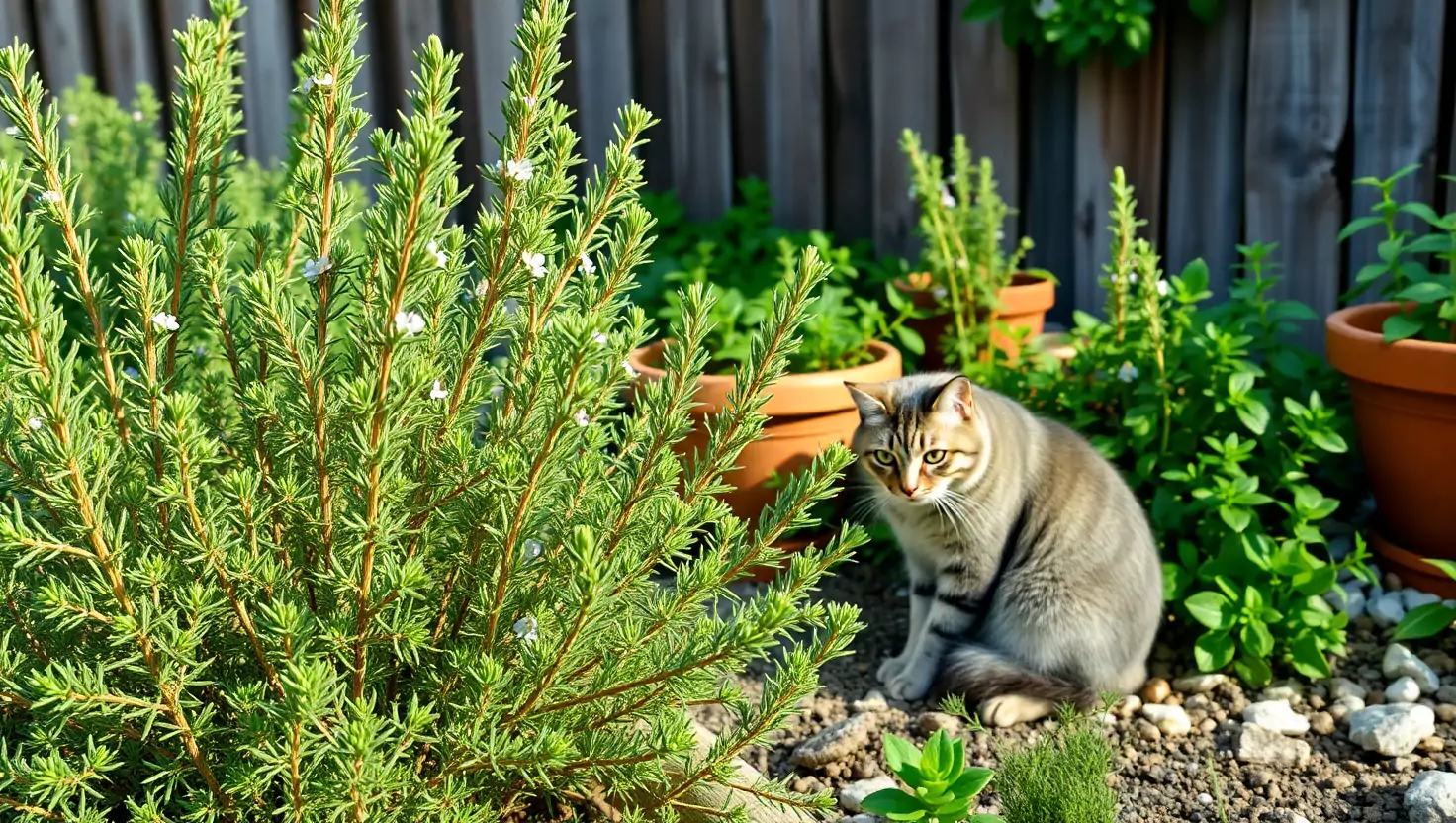
Basil (Ocimum basilicum)
Basil is a must-have in every kitchen. If you are using pesto, pizza, or a salad, basil offers a burst of flavor and scent and is non-toxic to your cats. While there may be a curious kitty who sniffs or swats it, basil won’t hurt her and is safe if her curiosity allows for a tiny nibble.
This leafy green herb loves warm sunny spaces and appreciates being watered regularly. Basil has natural insect repellent properties, so it can help protect other plants you may have on your windowsill or balcony. Basil is also fast-growing and easy to trim for use in daily cooking.
Top Features:
- Tasty for cooking
- Safe for cats & bug-repellent
- Grows fast in sunny sills
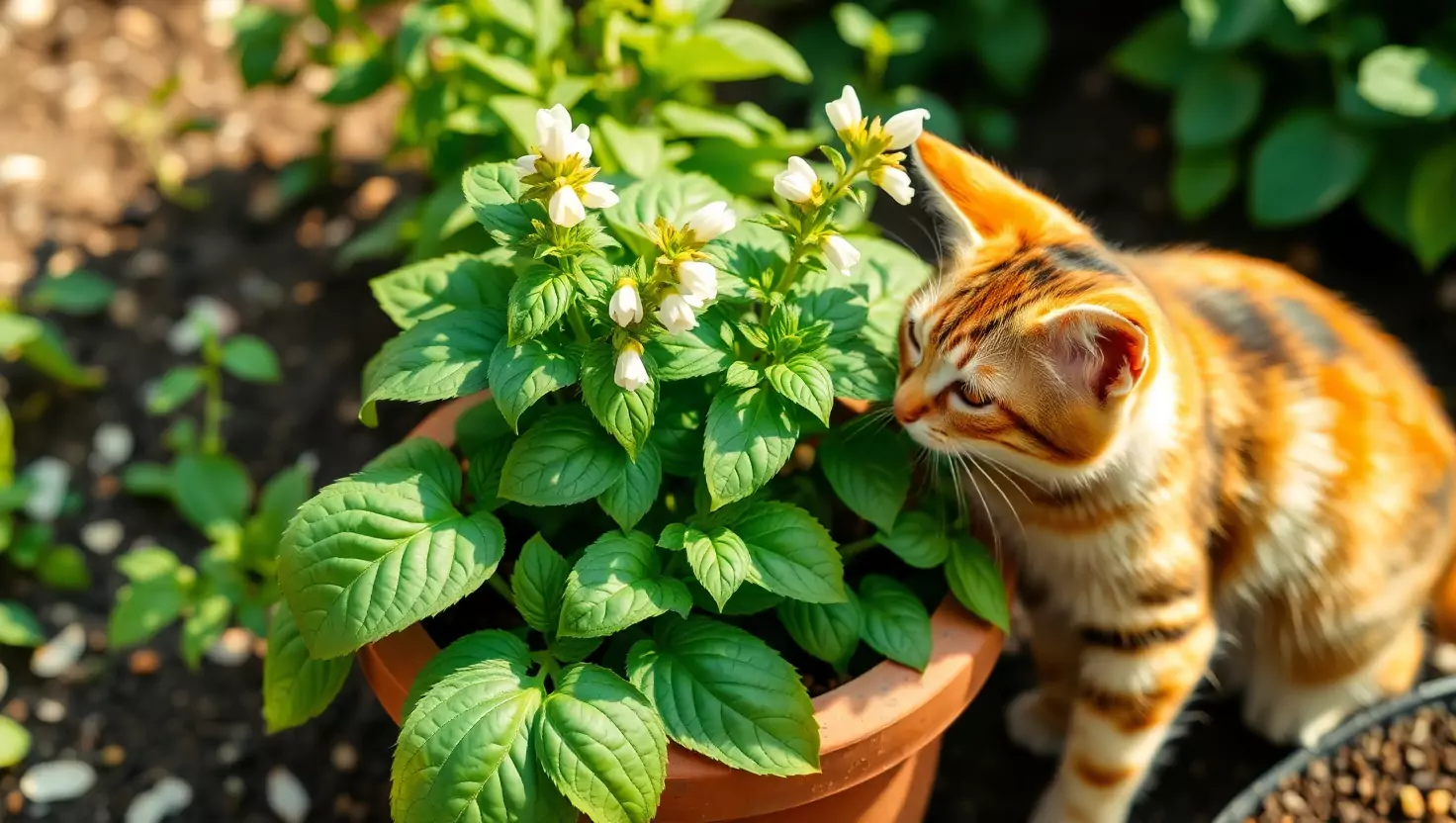
Wild Chives (Allium schoenoprasum)
Unlike their look-alikes – garlic and onion, which are toxic to cats, wild chives are non-toxic and considered safe. The grassy herbs have a mild flavor and are an excellent garnish for baked potatoes, soups, or salads. When wild chives bloom, there are purple pom-pom flowers in the spring and summer.
Wild chives like full sun and well-drained soil and can easily be cultivated in containers or garden beds. They are pollinator-friendly because they will attract bees and butterflies, and if you are ever confused about the varieties, check the botanical name to ensure you are growing Allium schoenoprasum.
Key Features:
- An edible, mild-flavored herb
- Purple blooms are attractive to pollinators.
- Non-toxic alternative to garlic or onion
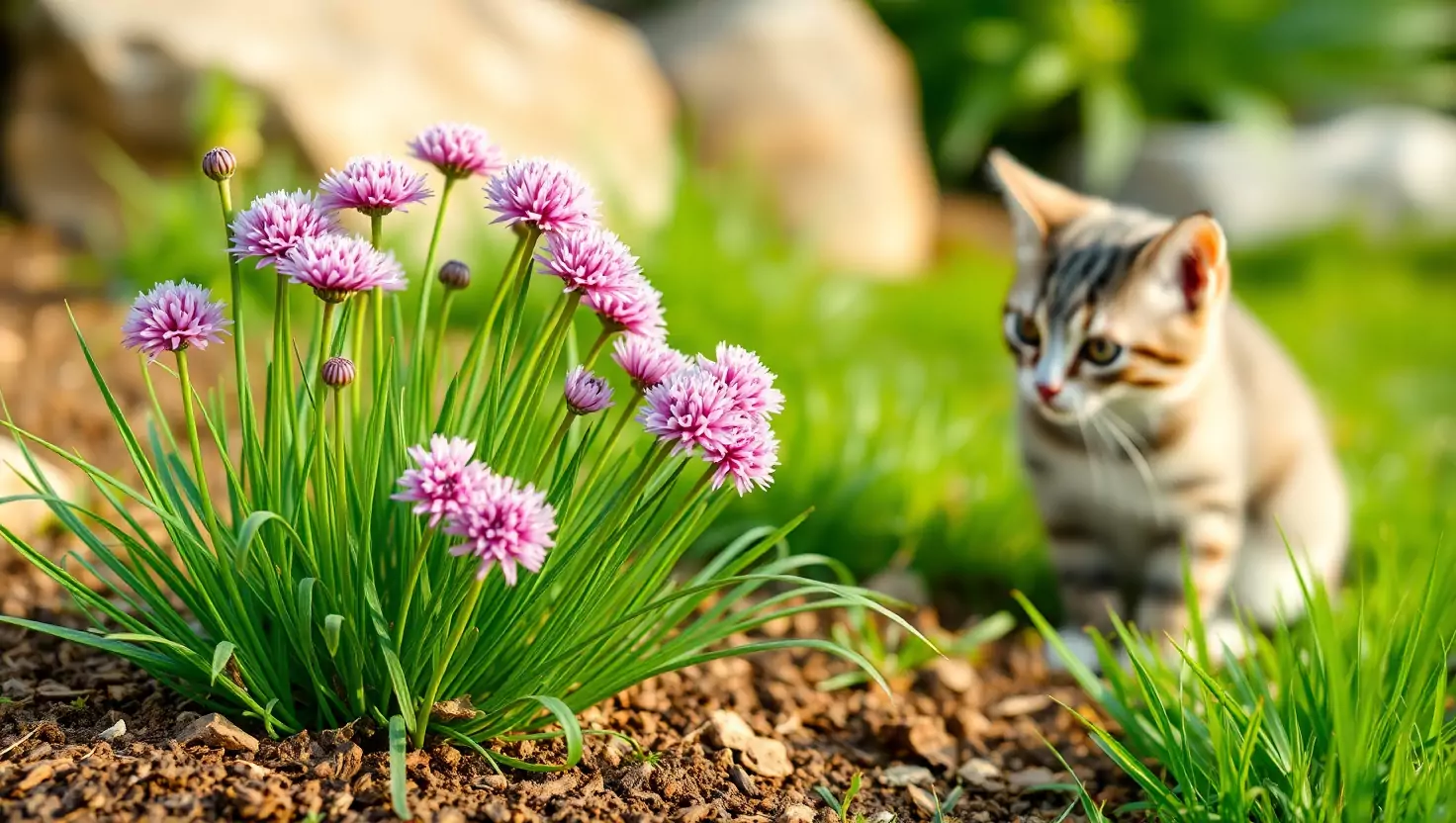
Pineapple Plant (Ananas comosus)
The pineapple plant is a tropical beauty that can add a dramatic touch to your home and can thrive indoors or outdoors on a bright patio. The fruit it makes indoors is typically not sweet and edible, but the plant is cat-safe and non-toxic if you want to grow it around your feline friends. Its spiky leaves may also deter the cat from hanging around too long.
Originating from South America, the pineapple grows well in bright, warm places and requires minimal watering. In time, the pineapple plant will produce a small ornamental fruit at its center – a great conversation starter, even if you don’t intend to eat it. With its sculptural form, it’s a fun way to add some tropical vibes to your home, all without your pets consuming it.
Top Features:
- Tropical flair
- Non-toxic to cats
- Easy to grow with plenty of light

Unique Decorative Houseplants Safe for Cats
If you are interested in houseplants that are attractive in their own right and completely safe for your precious feline friends, this list is for you. These houseplants can enhance your home with style and personality while also giving you peace of mind that your pet is safe! From beautiful hanging vines to lush, quirky foliage, each plant has its charm and resilience, plus peace of mind for cat owners.
String of Hearts (Ceropegia woodii)
The String of Hearts is a beautiful trailing plant. The leaves are delicate hearts that dangle from long vines. This plant is excellent in hanging baskets, high shelves, or plant stands, where the vines can dangle and create a romantic and whimsical look. The best part? It is non-toxic to cats. You won’t have to worry if your curious kitty bats at the vines or creeps a little too close.
This semi-succulent thrives under bright, indirect light and doesn’t require constant watering, making it a perfect low-maintenance option for your home. With its unique pattern and delicate leaves, it’s a natural conversation starter, and the way it trails down is beautiful yet playful.
Top Features:
- Trailing vines with heart-shaped leaves
- Very low-maintenance, drought-tolerant plant
- Completely non-toxic for pets
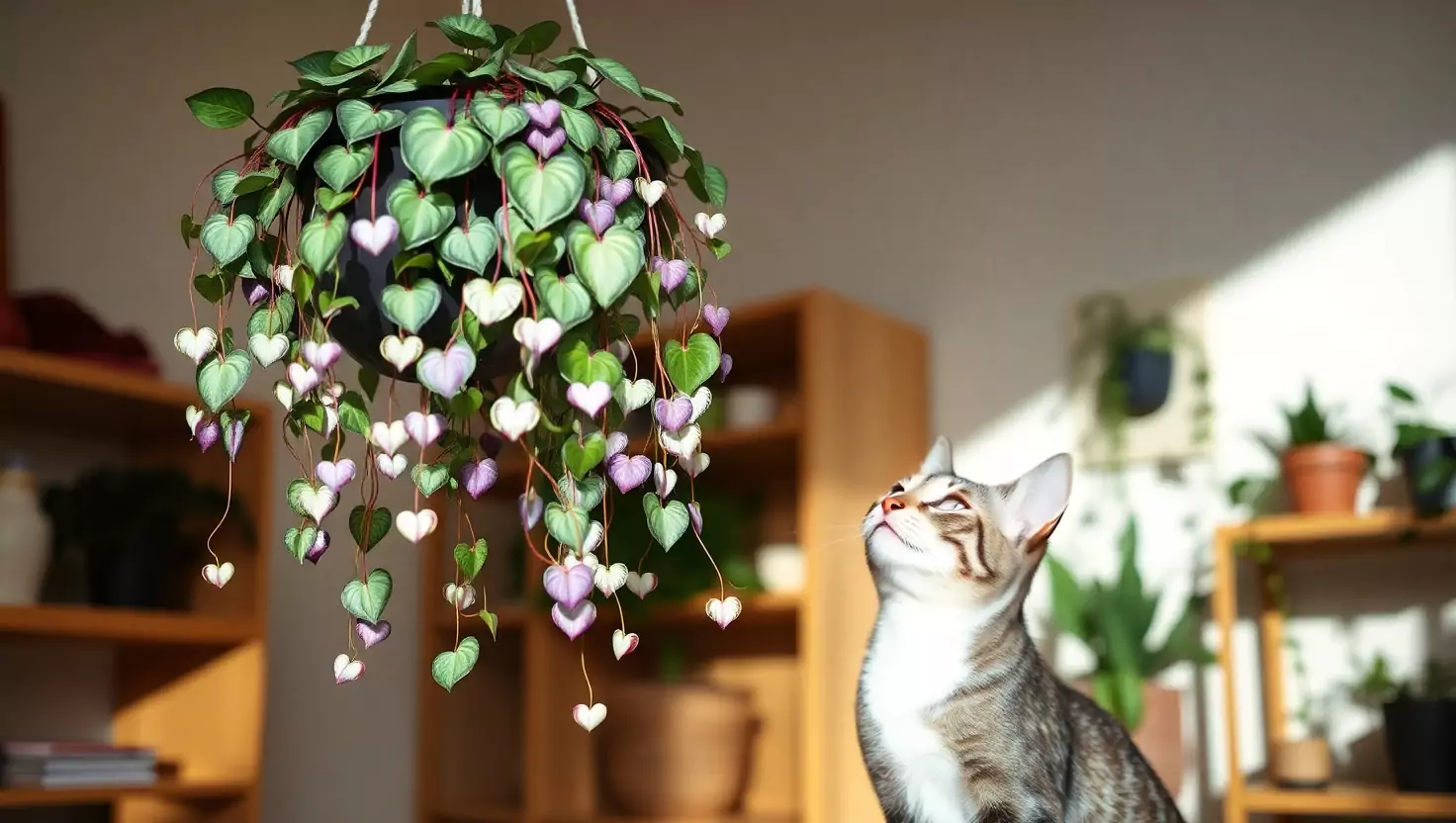
Watermelon Peperomia (Peperomia argyreia)
The Watermelon Peperomia has bold, patterned leaves that resemble the rind of the fruit, so it steals the show wherever it is on a table or shelf. The plant is compact and tidy, with a vibrant pop of green, and it is completely safe for cats. The soft leaves and small size make it the perfect companion for small areas and homes with pets.
Watermelon Peperomia prefers bright, indirect light and watering if the top inch of soil feels dry during the spring and summer growing season. It doesn’t grow all that tall, so you don’t have to worry about it outgrowing your space, and it doesn’t require too much humidity or misting either. It’s a stylish yet safe option for plant lovers who want to enjoy a beautiful plant with peace of mind.
Top Features:
- Big, striped foliage that looks like a watermelon
- Small and easy to care for
- A safe, non-toxic plant for cats
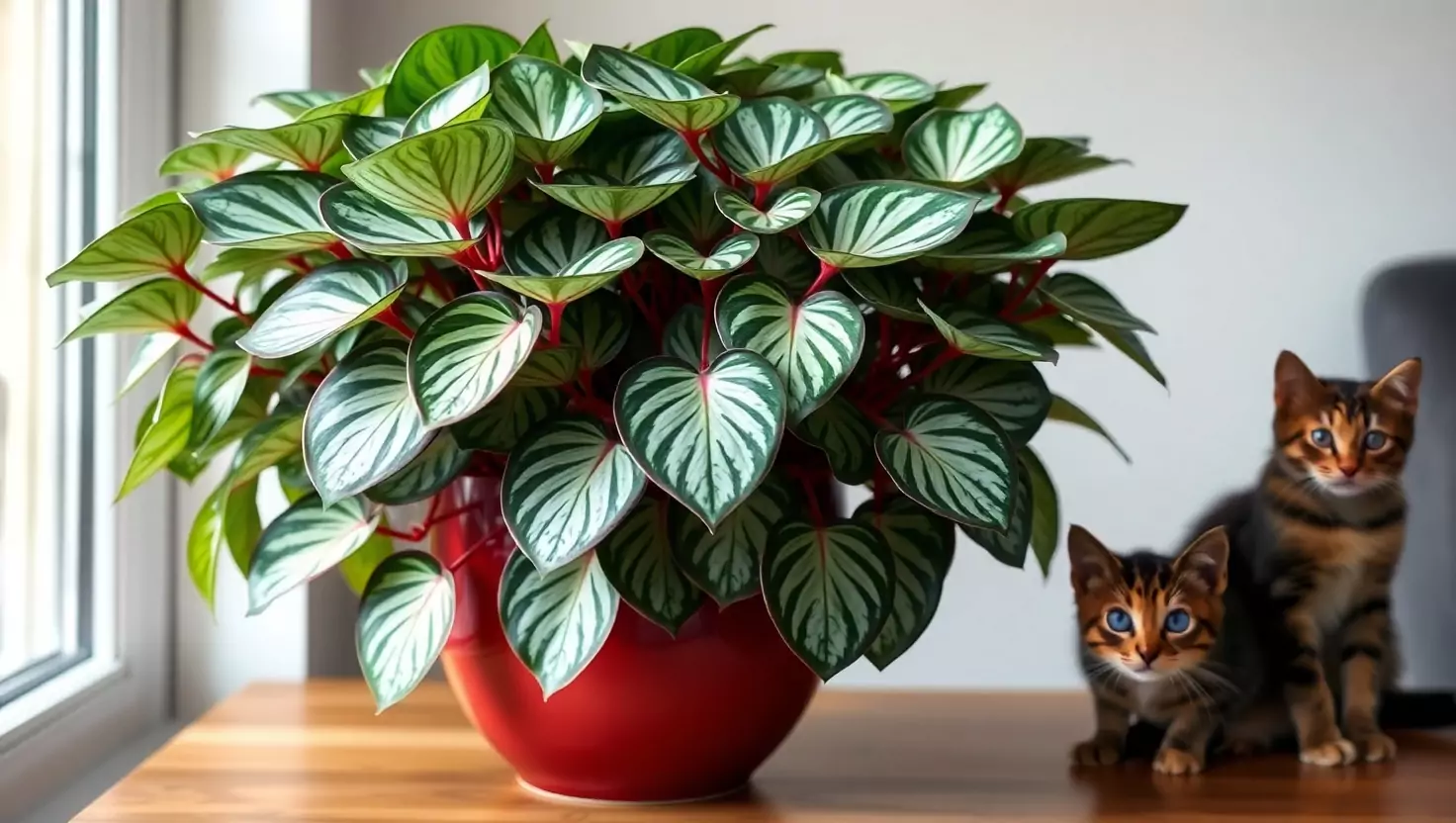
Cast Iron Plant (Aspidistra elatior)
The Cast Iron Plant truly lives up to its name; this houseplant is nearly indestructible. Even if you forget to water it, keep it in low light, or expose it to temperature fluctuations, it remains strong and grows nonetheless. Its beautiful, deep-green leaves provide a lush look for your home’s darker corners, and it is 100% cat-safe.
It’s ideal for plant beginners or busy pet owners looking for a functional green companion. It doesn’t flower often indoors, but its tough leaves stand out on their own, providing a lush, earthy aesthetic. It’s also one of the few houseplants that do well in dark spaces.
Top Features:
- Extremely resilient, beginner-friendly
- Grows in low light and neglect
- Safe choice for curious cats
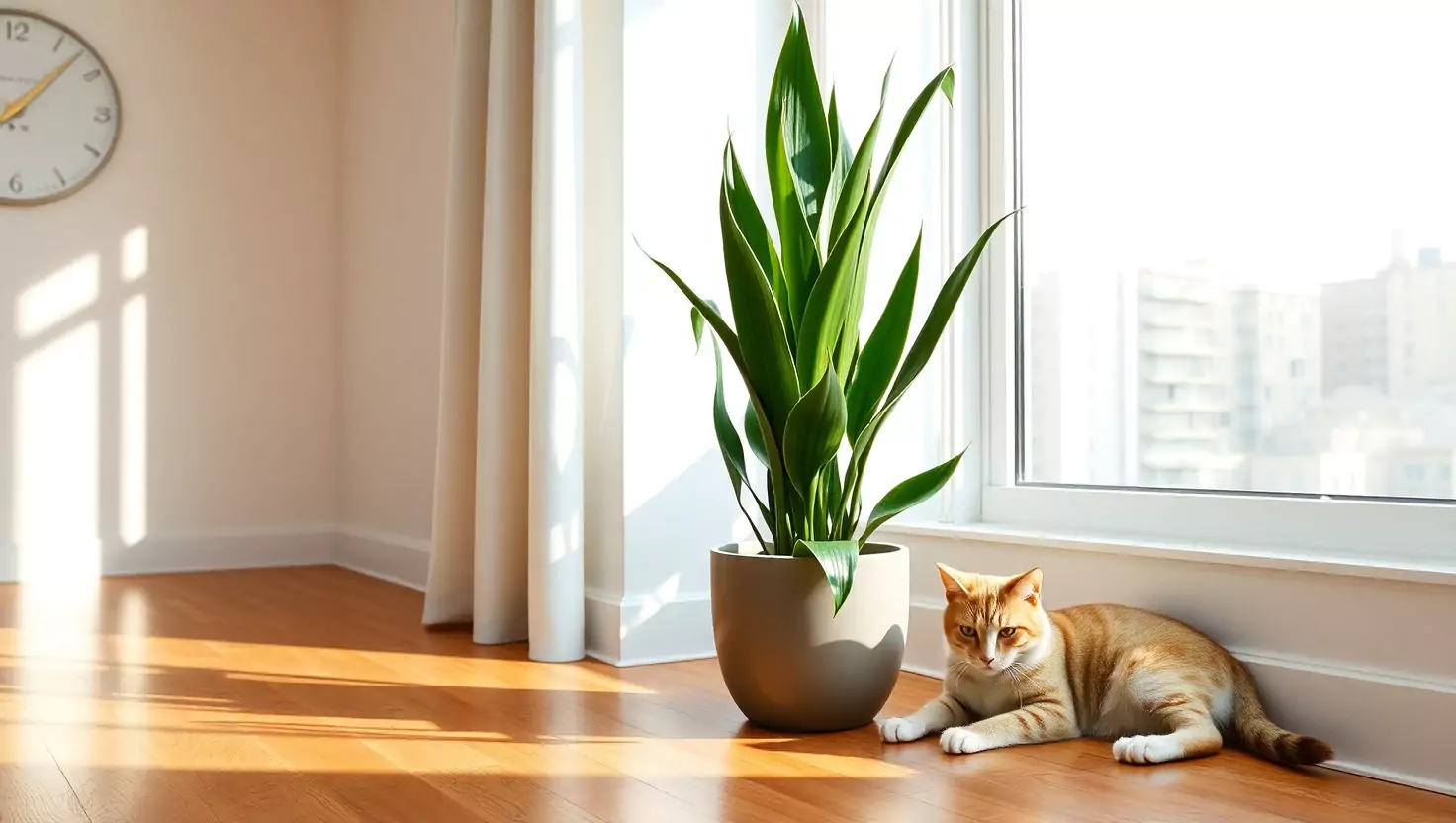
Golden Polypody (Phlebodium aureum)
Golden Polypody is an incredibly rare and beautiful fern with wavy, blue-green fronds that are almost too soft and dreamy to believe. If you love interesting textures and want a statement plant that is a little out of the ordinary, this is a great plant for you. Golden Polypody is native to tropical forests and prefers humid environments, making it great for kitchens or bathrooms. It is safe for your cat, too!
This plant enjoys bright, indirect light and consistency in moisture, although it does not want to soak in soggy soil. Mist it occasionally or use a pebble tray for the humidity it craves. The Golden Polypody is not only visually beautiful, but safe for your home in case you have a very playful cat!
Top Features:
- Mesmerizing blue-green fronds
- Enjoys humidity and a bright space
- Safe and gentle for cats
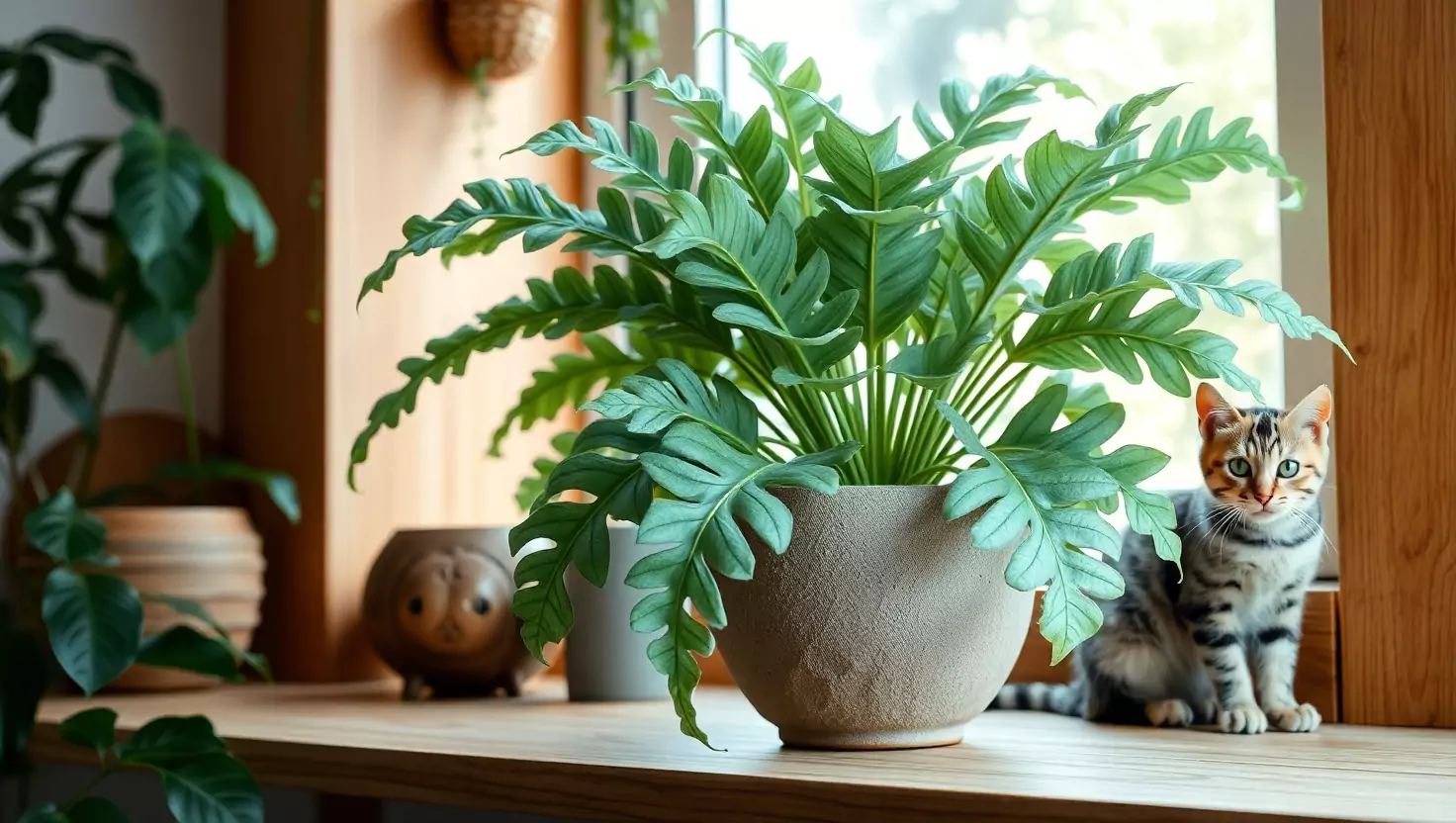
For assistance keeping your greenery lush and thriving, check out this houseplant care advice suitable for both beginner and experienced plant parents.
What to Do if Your Cat Eats a Toxic Plant
Accidents can happen anywhere, even in safe, cat-friendly homes and in safe, cat-friendly spaces. If you believe that your cat has ingested a poisonous plant, you need to act quickly, but it is also important to stay calm. You have to keep in mind that time is critical; here is how to deal with it in the first few minutes to save your cat from serious problems.
Emergency Steps to Take Immediately
- Get Rid of Any Plant Material
If you find your cat in the act, or discover a chewed plant around your house, carefully remove any plant material from their mouth or fur. Be careful, a stressed cat that is confused may try to wiggle or struggle. Move slowly and try to keep calm.
- Identify the plant (or take a picture)
If you know what the plant is, write down the name. If you don’t know what it is, take a picture from different angles. It will help your veterinarian or poison control expert identify the toxin more quickly and recommend appropriate treatment.
- Call a Vet or Poison Hotline Right Away
Call your vet right away or contact a pet poison hotline available 24/7. Please don’t wait until it becomes worse. Even if your cat seems fine at first, some toxins take time to affect their body.
- Don’t Induce Vomiting Unless advised.
Even though it may seem like a great idea, don’t ever try to induce your cat to vomit unless a professional tells you to do so. Some substances can do even more harm on the way back up than on the way in.
Unsure if your plant is safe? Use the ASPCA Toxic and Non-Toxic Plants List to quickly determine if a plant is toxic to cats.
When to Contact Your Vet
Keeping your cat healthy is essential, and if you’re worried about plant poisoning, acting fast can help you get your cat the help they need. Cats can be curious about everything around them, and eating even one or two pieces of a plant that may be poisonous can lead to serious health consequences. So it’s very important to know when it’s time to reach out for help.
If Your Cat Has Eaten a Known Toxic Plant
Even a small amount of any poisonous plant can do damage. Some plants, such as the lily, are very toxic to cats, and only one leaf or pollen can be deadly. Others, such as philodendrons or dieffenbachia, can cause burning of the mouth or a stomach upset. If your cat has come in contact with any of the plants on the toxic list, do not wait to “see what happens”. Call your vet right away.
If your cat is showing any abnormal behavior, like throwing up, excessive drooling, or sudden lethargy, it could be an indication of something serious. Find out more about some of the signs of a sick cat so that you can know what to look for in terms of early warning.
If You’re Unsure Whether the Plant is Safe
Can’t identify the plant? Or are you uncertain as to whether it’s poisonous or not? If so, play it safe and call your vet or a poison control hotline. A plant may appear harmless, but there are plant species (especially tropical or ornamental varieties) that contain compounds toxic to cats. If you would like to identify the plant and it is safe to do so, take a clear photograph of it to show your vet or put it online to see if somebody can identify it.
If Your Cat Shows Concerning Symptoms
These signals could show up within minutes to hours after ingestion of the toxin and should always be a concern. Even subtle changes in behavior could be a sign of distress or toxicity.
Look for early warning signals like:
- Vomiting
- Diarrhea
- Excessive drooling
- Pawing at the mouth
- Decrease in activity or lethargy
- Trembling or shaking
- Unusual hiding or restless behavior
If They Seem “Off” or Not Quite Themselves
Cats are very good at hiding pain and illness. If your cat stops eating, seems withdrawn, or is acting differently than usual – even if there are no observable symptoms – it could be an early sign of poisoning or discomfort. A vet appointment can help clarify any serious issues before they become serious.
Trust Your Instincts
When in doubt, call your veterinarian. It is better to overreact than to underreact. If you take action quickly, you can help prevent unnecessary suffering for your kitty and potentially save their life. Many issues related to plant toxicity and intoxication are treatable if diagnosed early, so never hesitate to seek professional help.
Helplines and Online Resources
The following are some reputable, pet-specific poison control resources that you can store for emergencies:
- ASPCA Animal Poison Control Center (USA)
📞 1-888-426-4435
www.aspca.org/pet-care/animal-poison-control
(Keep in mind: there may be a consultation fee.)
- Pet Poison Helpline
A 24/7 resource regarding any pet poisonings, available worldwide.
- Cats Protection (UK)
Very good resource for general cat safety and cat care in the UK.
- Your Local Emergency Vet
Most emergency clinics have an after-hours number or on-call staff. Keep their contact info saved, just in case.
Understanding how to respond in those first few moments can make a huge difference. Always be proactive, stay calm, and get some help right away if you find your cat eating something suspicious.
Recommended Tools for a Cat-Safe Garden & Home
Creating a cat-safe garden is not just about the selection of plants – it is also about their arrangement and your level of care. Using the right tools can help you accomplish a healthy, attractive residence and a safe environment for your inquisitive cat. Whether you have a brazen mouth in the house or want to keep things secure, these essentials will help you in your role as a pet parent and plant parent.
Pet-Safe Deterrent Sprays
If your cat likes to chew, then you need these sprays. Seek sprays containing natural bitter agents or citrus oils, both are safe for your cat, but not very appealing for chewing. A light mist around the pot (not on the plant) can help break the chewing behaviour without discomfort and safely.
Always test a small area for any damage to your plant or soil beforehand.
Hanging Baskets & Wall Shelves
Out of sight, out of paw! Hanging planters and shelves mounted high up are a great way to keep trailing plants like string of hearts or delicate ferns out of a cat’s reach, and a lovely way to add greenery in vertical spaces, especially in a small home or apartment.
Cats love to climb, too, so if you place shelves or cat trees for them nearby, it helps with their curiosity.
Fine-Mist Spray Bottles for Humid-Loving Plants
Safe plants like Boston ferns and calatheas like humidity, which most homes do not have. A fine mist helps increase moisture and keeps the leaves healthy without saturating the soil. We recommend using a mister with the finest, direct, even spray, so as not to damage leaves.
Use in the morning so the leaves get a chance to dry before nighttime, which will help reduce mold or mildew risks.
Organic Fertilizers (Avoid Bone or Blood Meal)
Fertilizers help keep your plants looking lively, but not every fertilizer will be cat-friendly. Be aware of fertilizers with bone meal, fish emulsion, or blood meal, as these can potentially smell like food and be harmful if consumed. Instead, try cat-safe alternatives such as seaweed-based fertilizers or compost tea.
Look For: Labels that contain a ” pet-safe “designation, especially when fertilizing edible gardens or indoor herbs.
The Pet Poison Helpline’s Emergency Plant Guide provides professional advice and current assistance with dealing with poisoning associated with plants.
FAQs
Can I keep toxic plants if they’re on high shelves?
No, it’s not advisable. Cats jump very well and often surprise us with how good they are at getting what they want. Even hanging plants or displaying plants on shelves become possible for a cat to get to when they are curious and want to leap. It’s best to avoid toxic varieties altogether.
Are “safe” plants completely risk-free?
Even cat-safe plants can cause a mild tummy upset when eaten in great amounts. Although these are non-toxic plants, some cats may still vomit or experience mild digestive reactions. Always pay attention to the behavior of your cat around the plants, and discourage over-nibbling.
Which palms are cat-safe vs. dangerous?
Kentia Palm, Areca Palm, and Parlour Palm are among the safest palms with respect to cats. These palms are non-toxic for cats. On the contrary, Sago Palm is highly toxic and lethal, even in small quantities. Always be sure of the species name if you are bringing palms into your home.
What should I do if I can’t identify a plant in my house?
Please take a picture and try plant ID apps or online gardening forums to identify it. Ask your vet or local nursery for help. Make sure you don’t assume a plant is safe until you have confirmed it is non-toxic for cats.
Are artificial plants a safer alternative?
While artificial plants are non-toxic, they are still hazardous if a cat is chewing or swallowing the synthetic materials. Cats can eat bits of plastic or fabric, which can cause a blockage in their digestive system. When using artificial plants, please keep them out of reach of your cat and pay attention to any loose parts.
Conclusion
Building a home or garden with greenery doesn’t mean putting your cat at risk. With non-toxic, cat-safe plants that still adhere, like spider plants, zinnias, rosemary, and others, you can enjoy the beauty of nature while keeping your furry friend safe. Plants brighten a home and create a healthier environment for curious kitties.
It’s important to monitor your cat’s actions at all times. Lots of planters can use creative placements such as hanging baskets or planters on shelves, and it’s important to check the safety of a plant prior to bringing it home. With a little consideration, you’ll be able to create an amazing pet-friendly oasis that displays your love of plants and your love of your cats at the same time.



